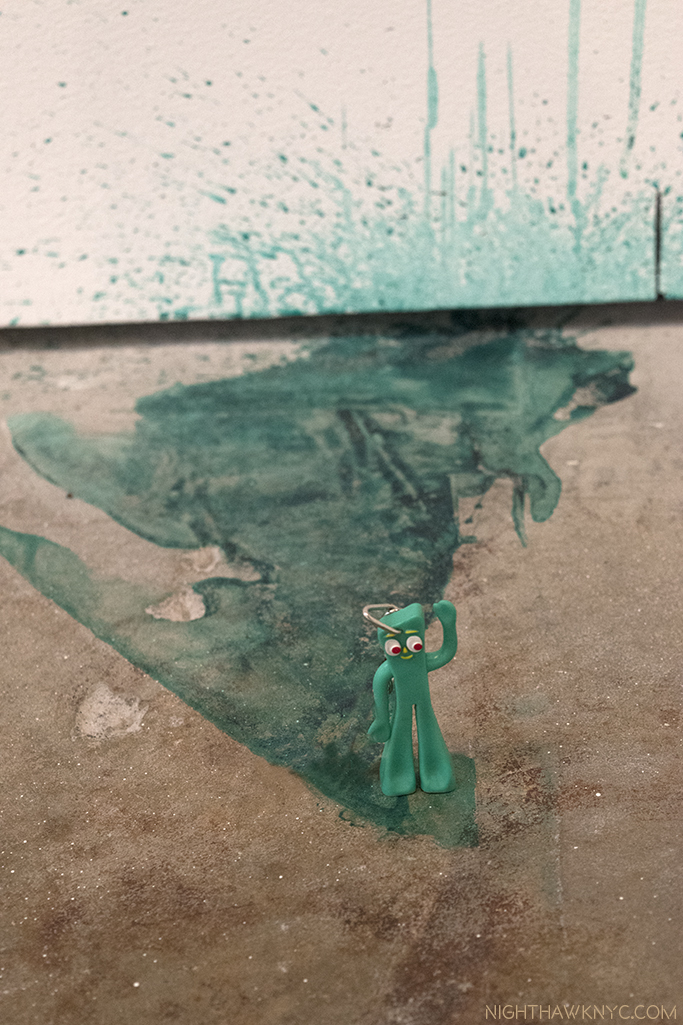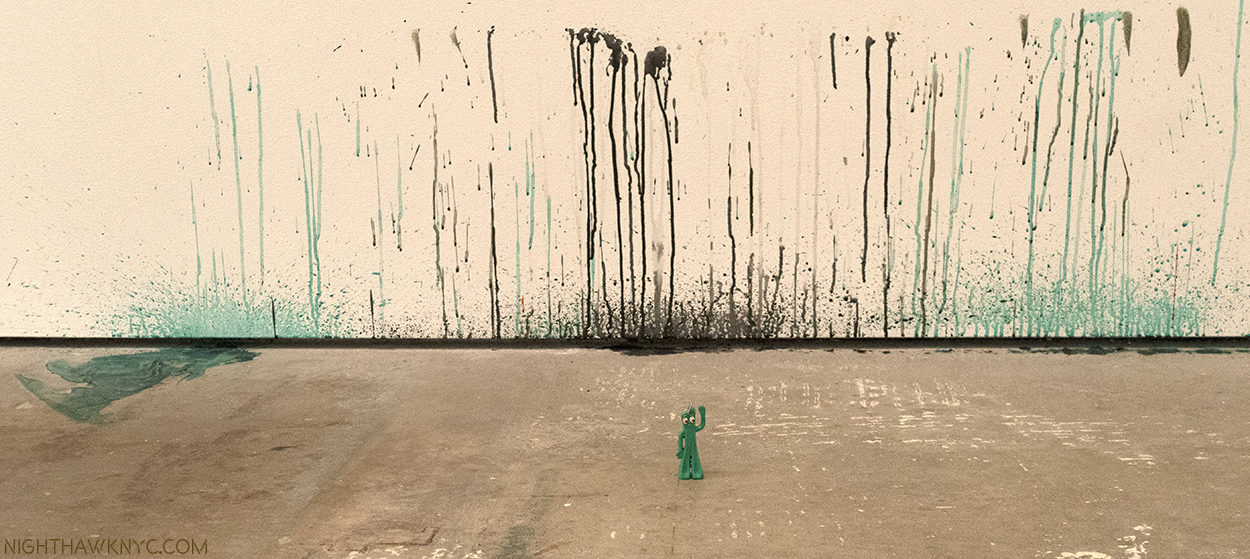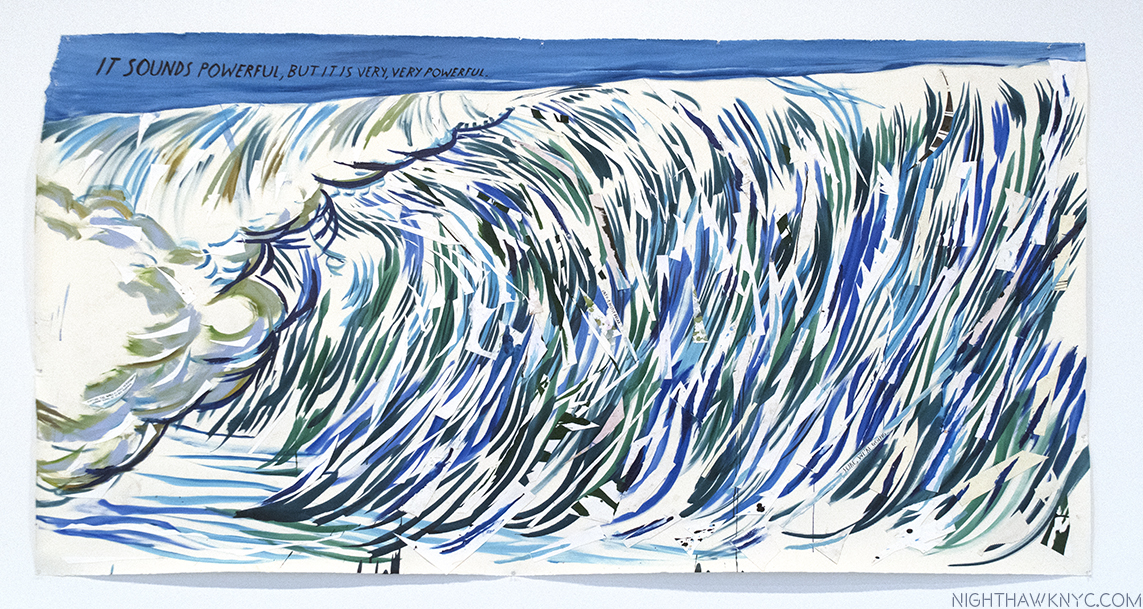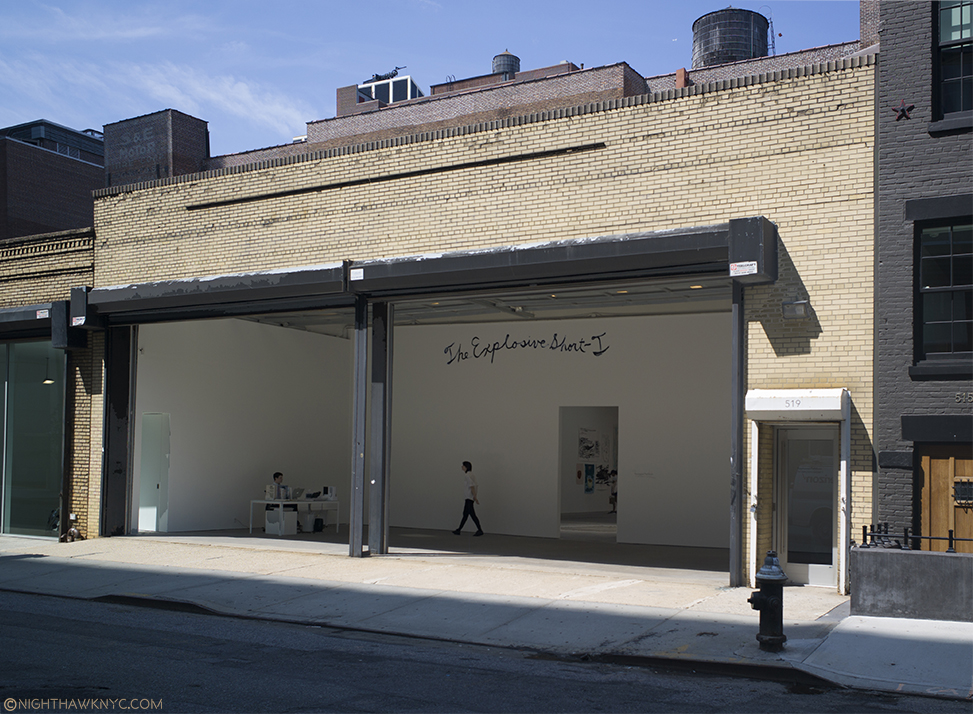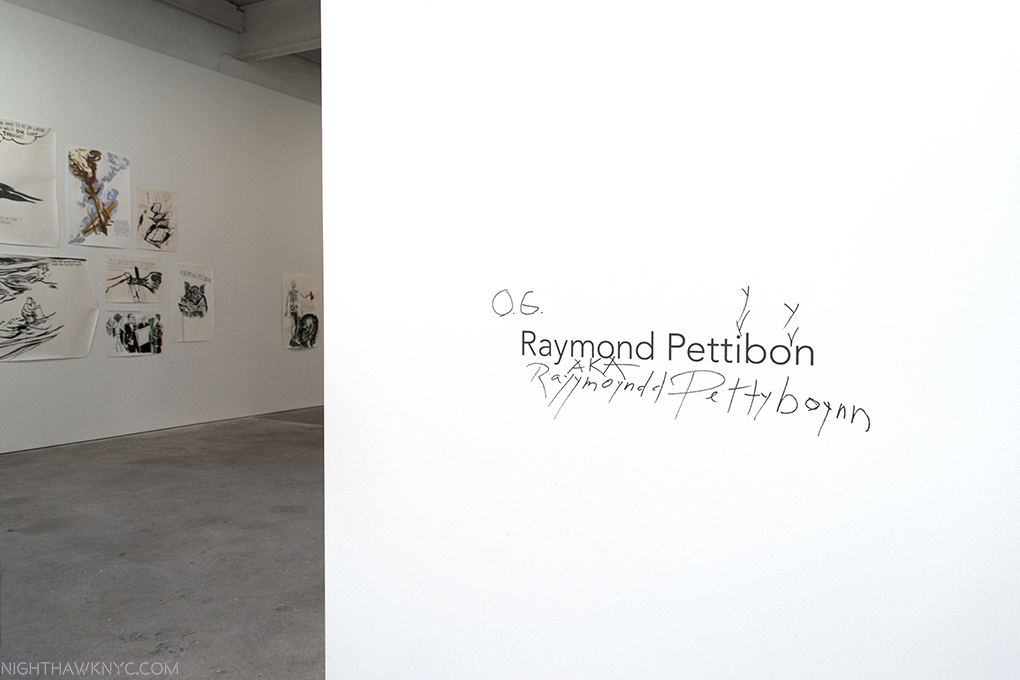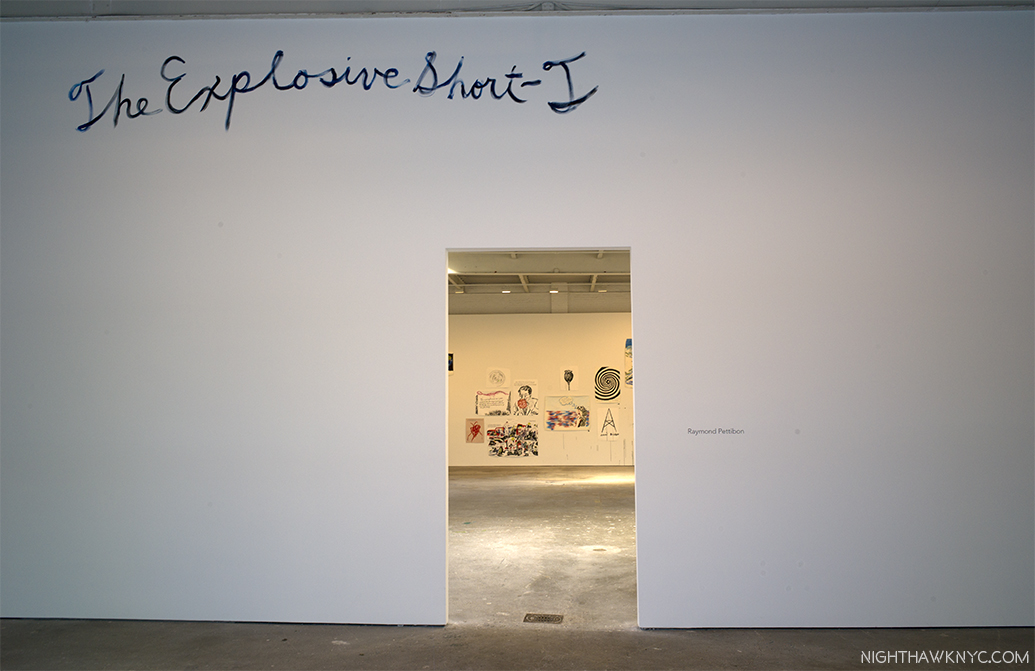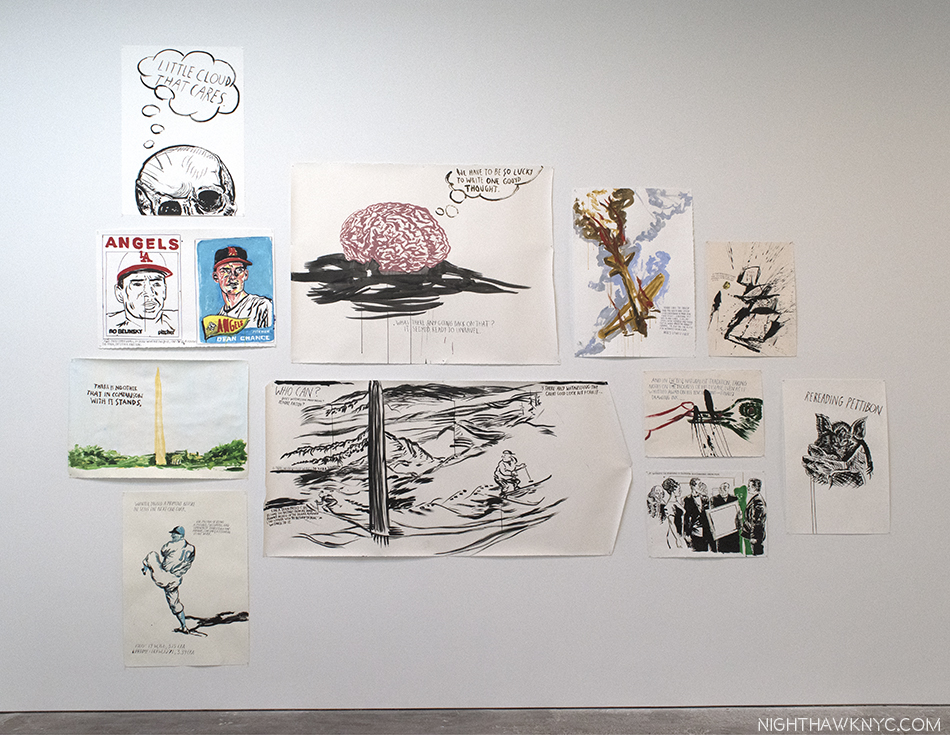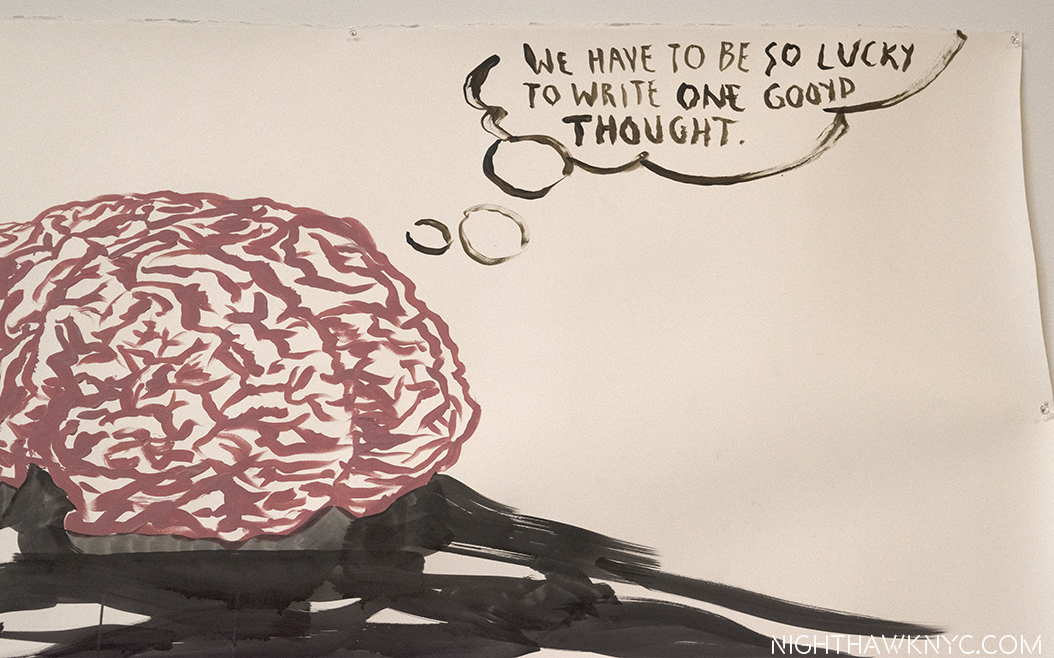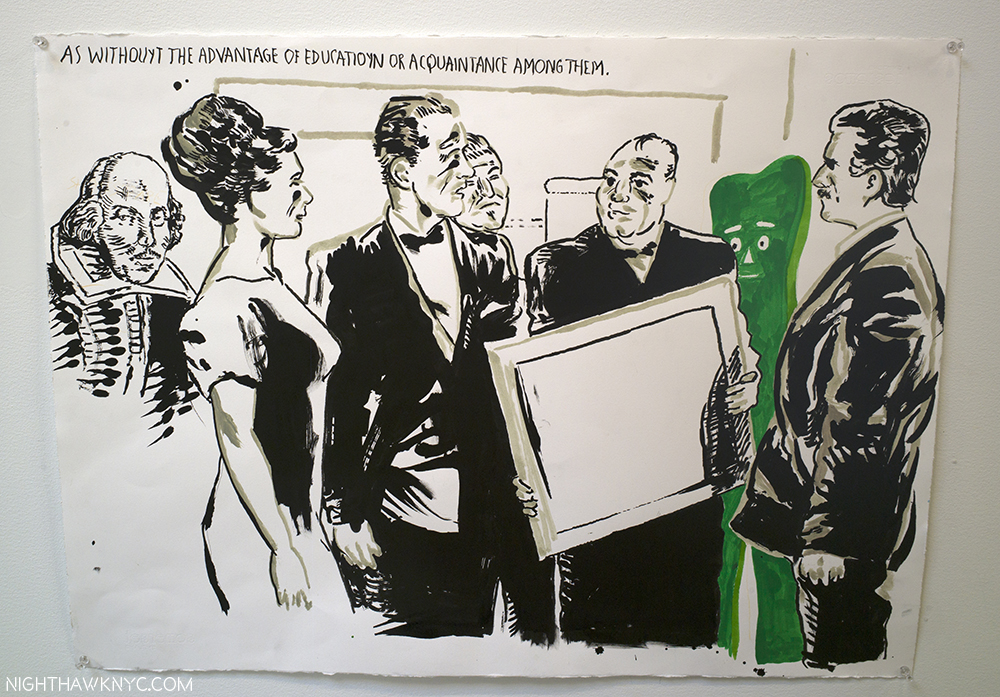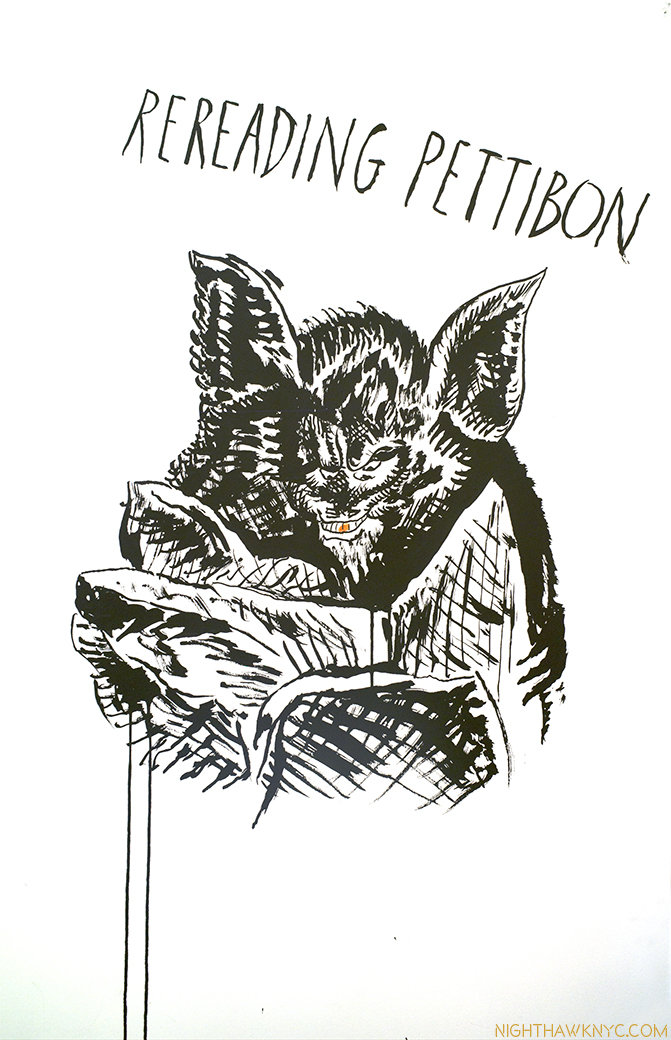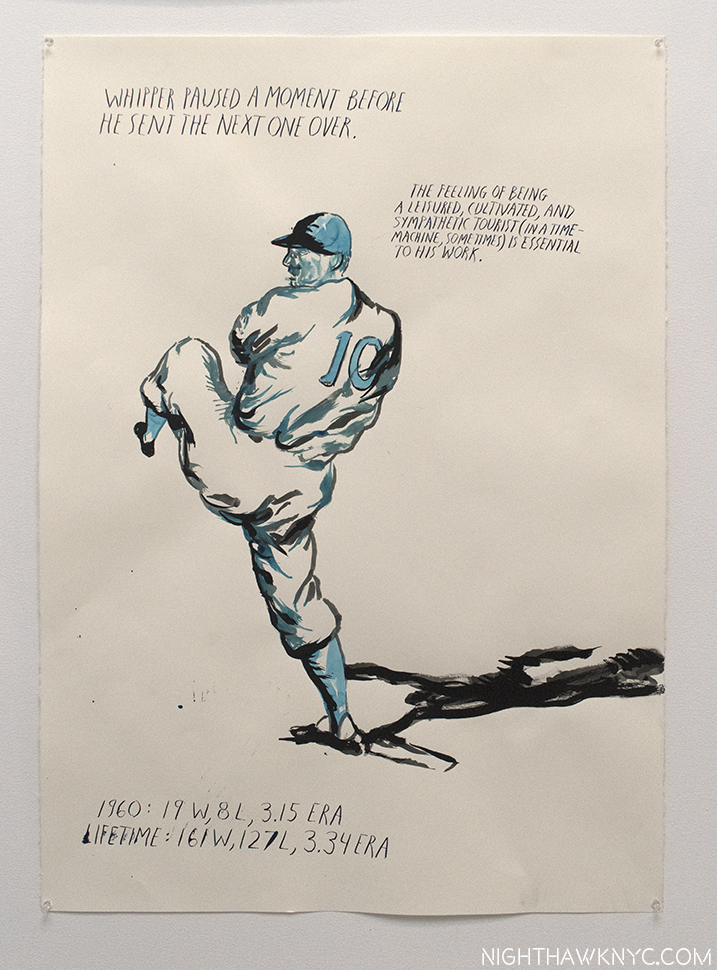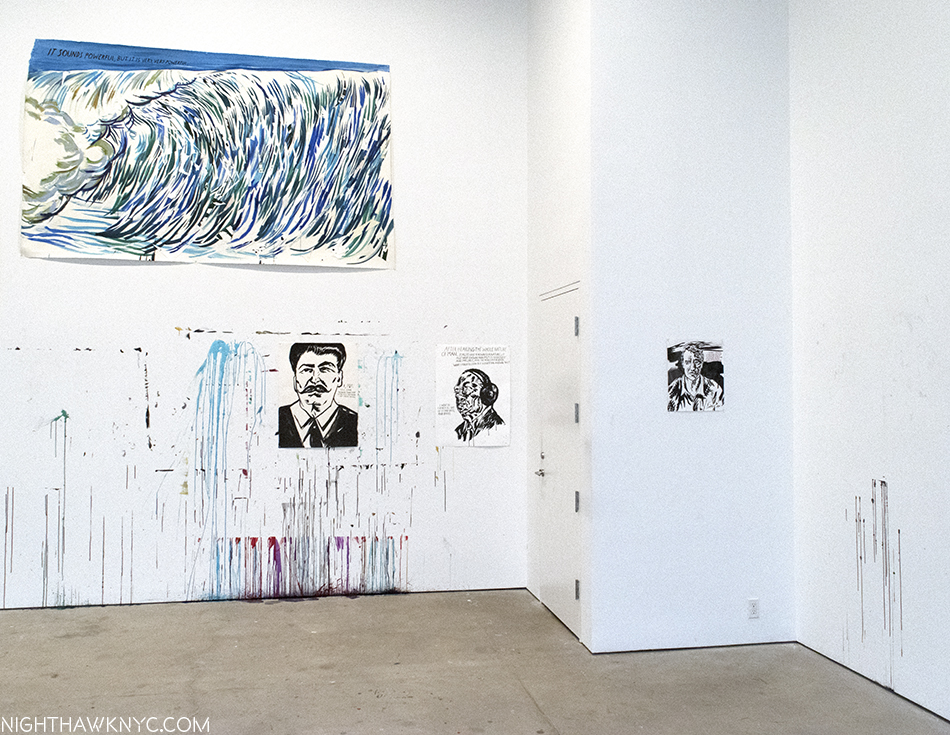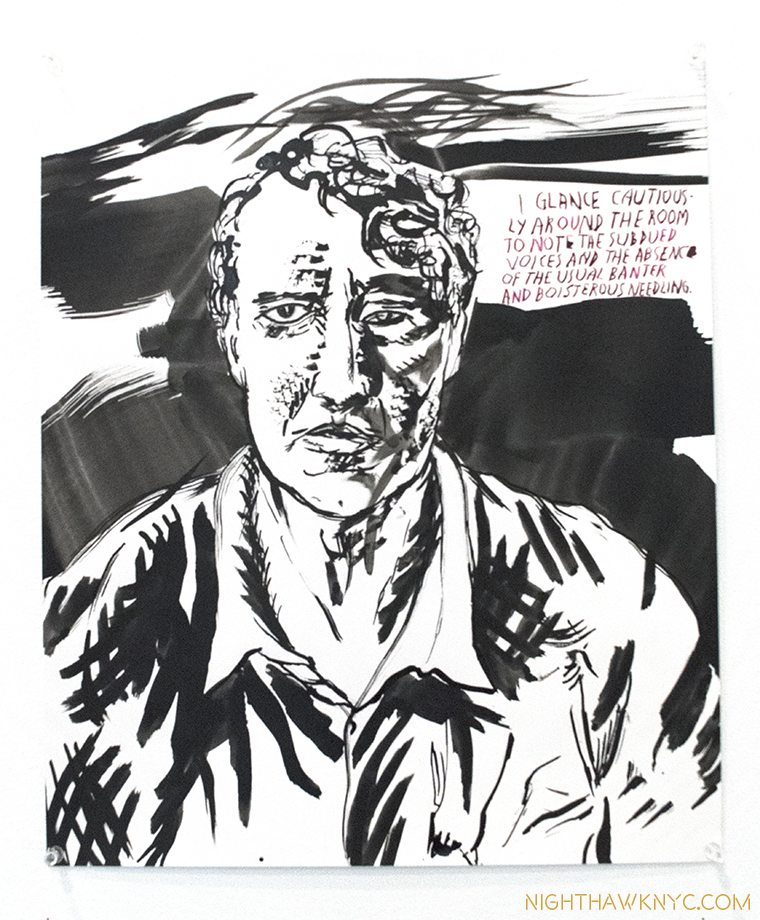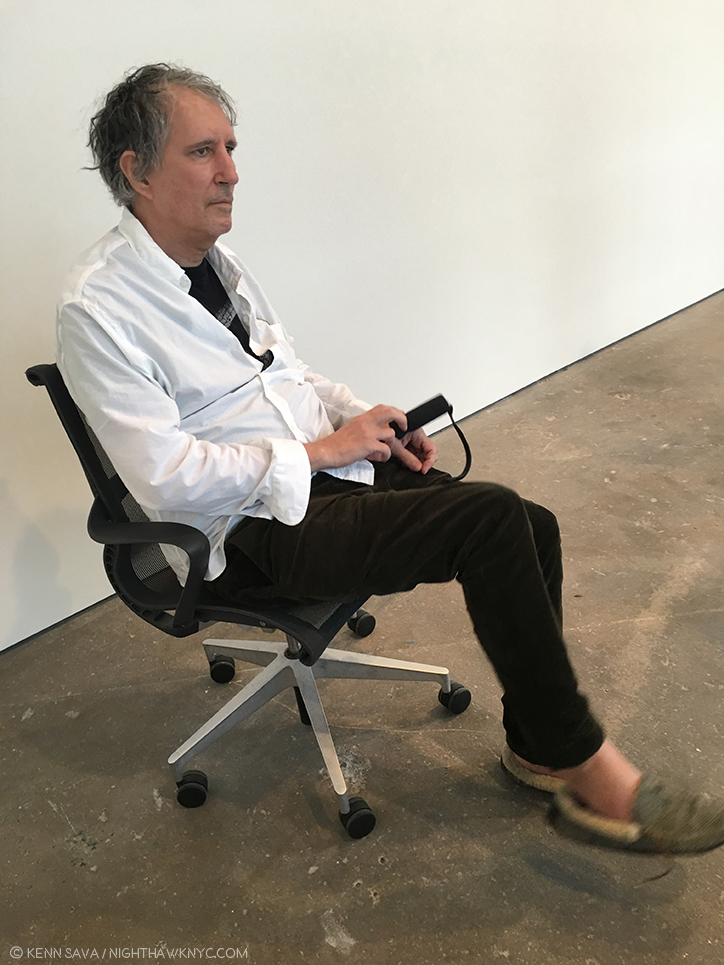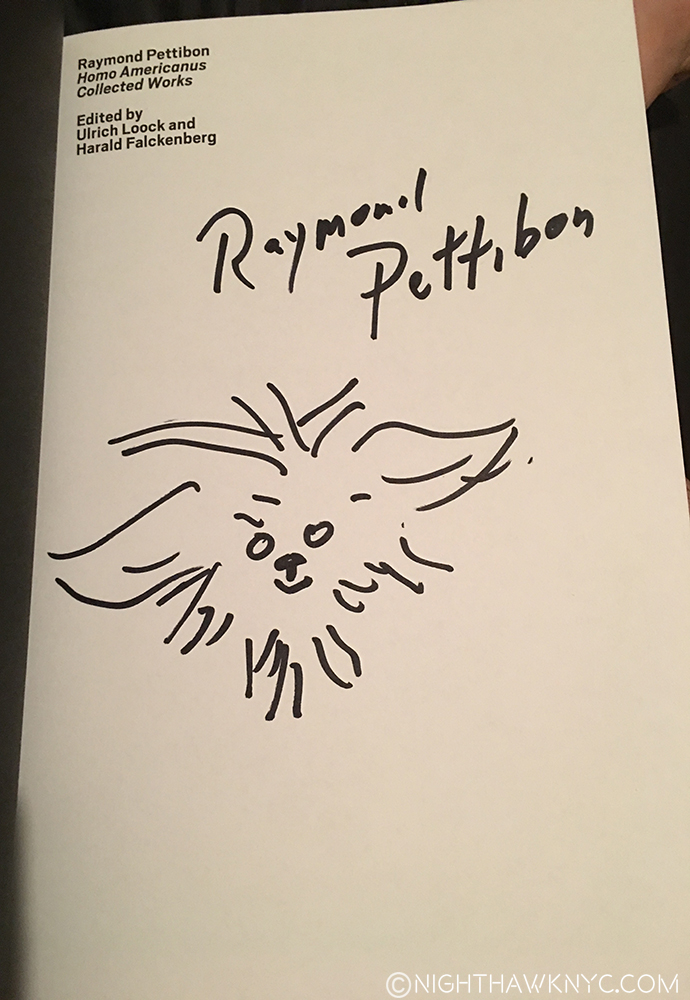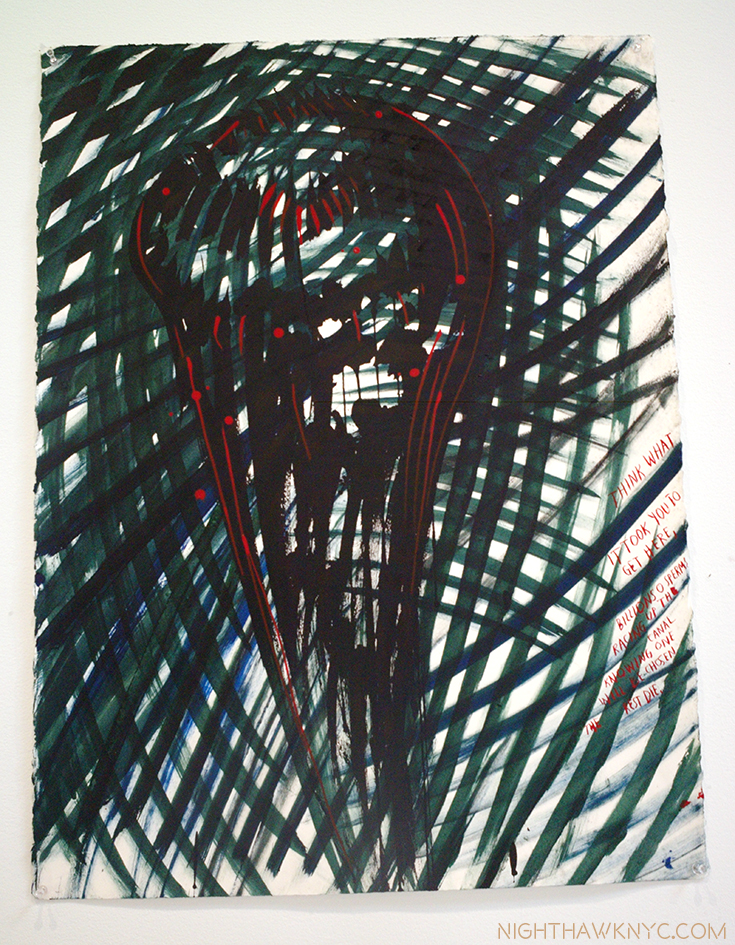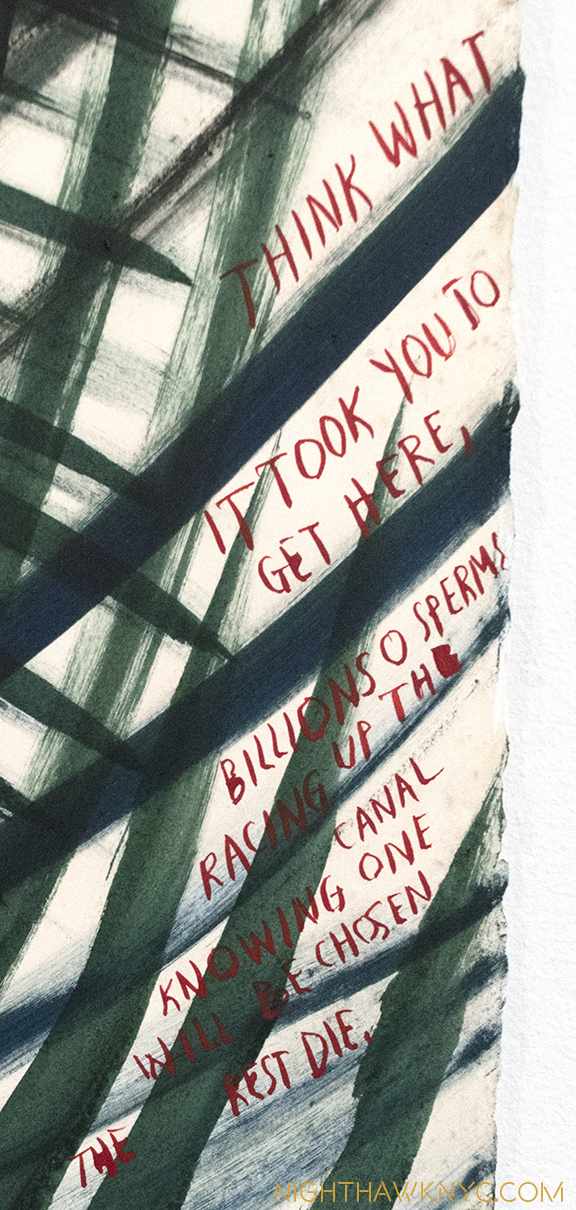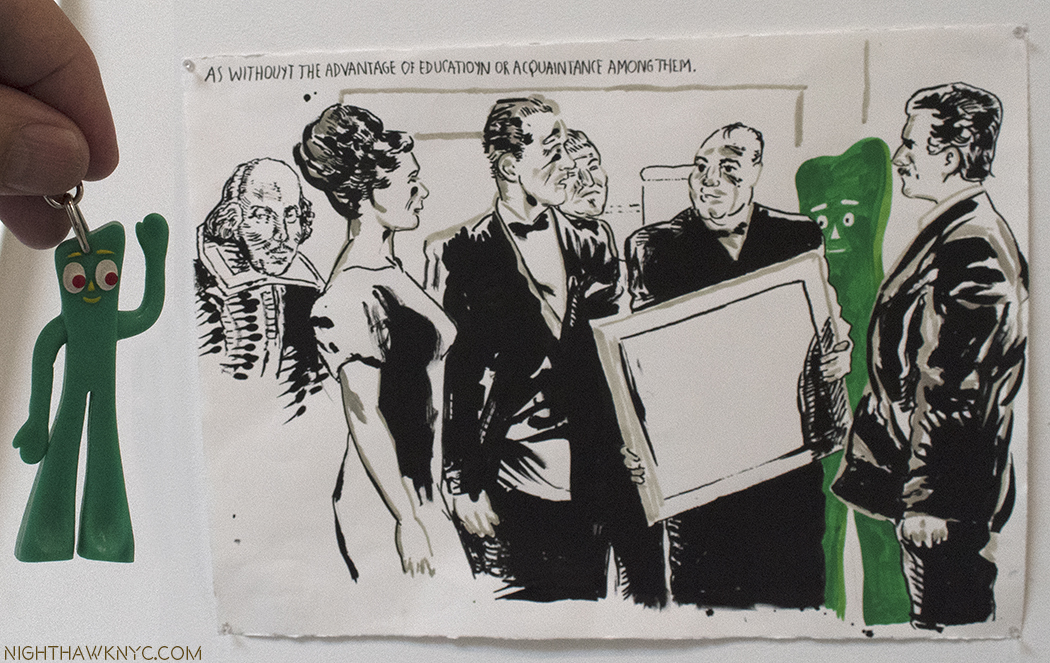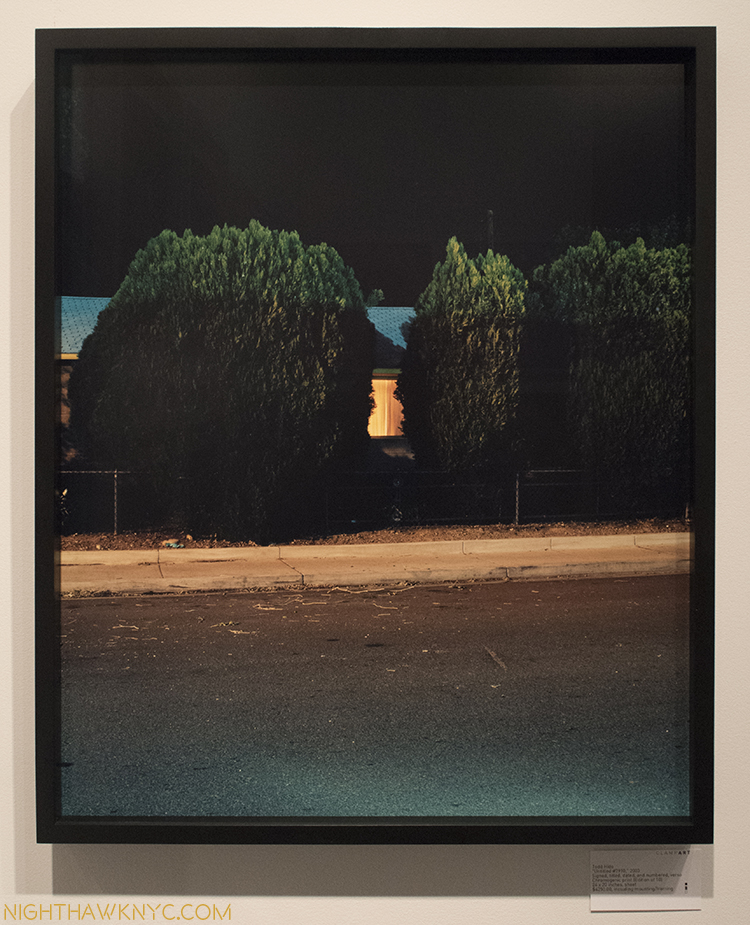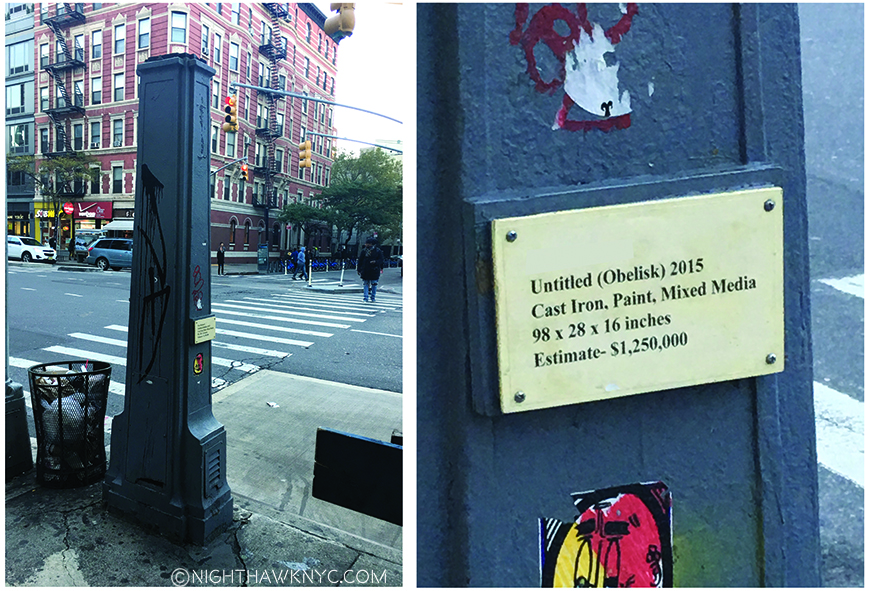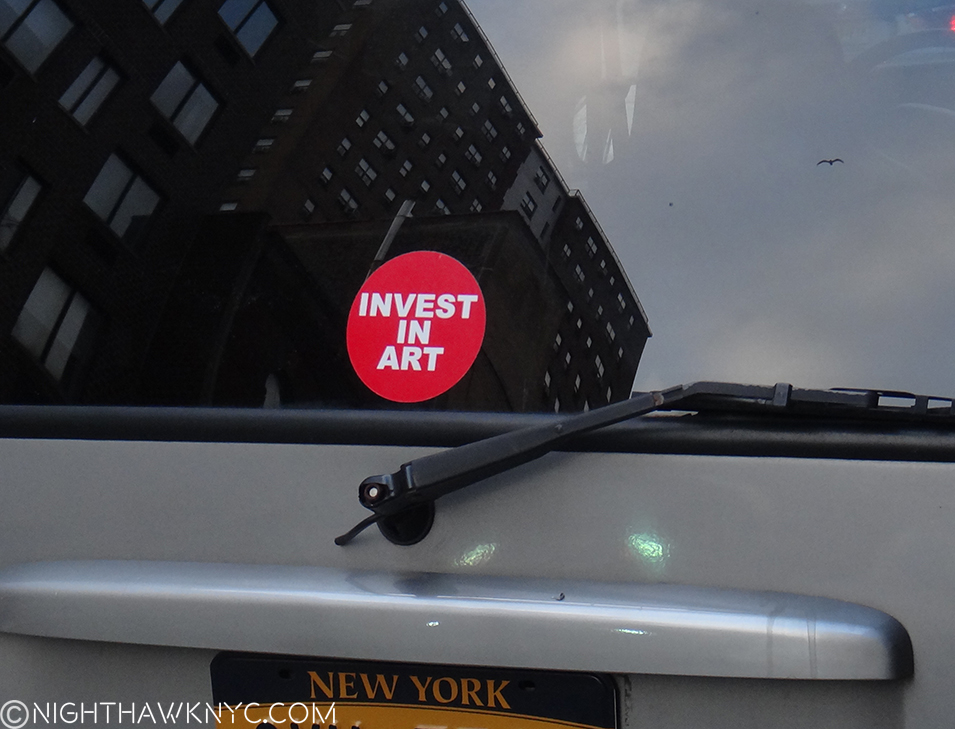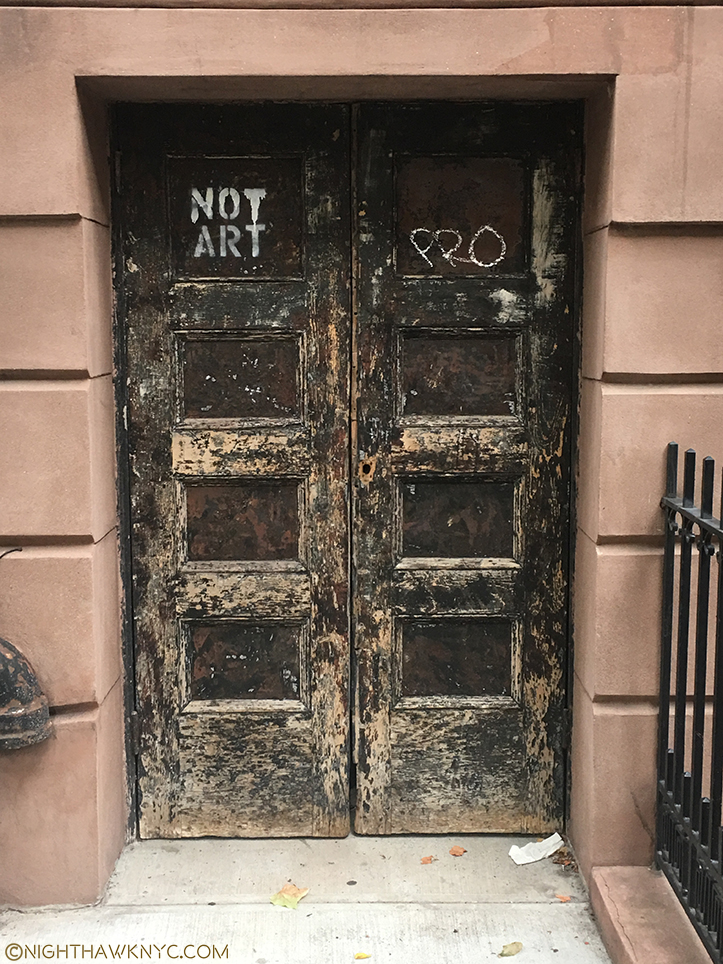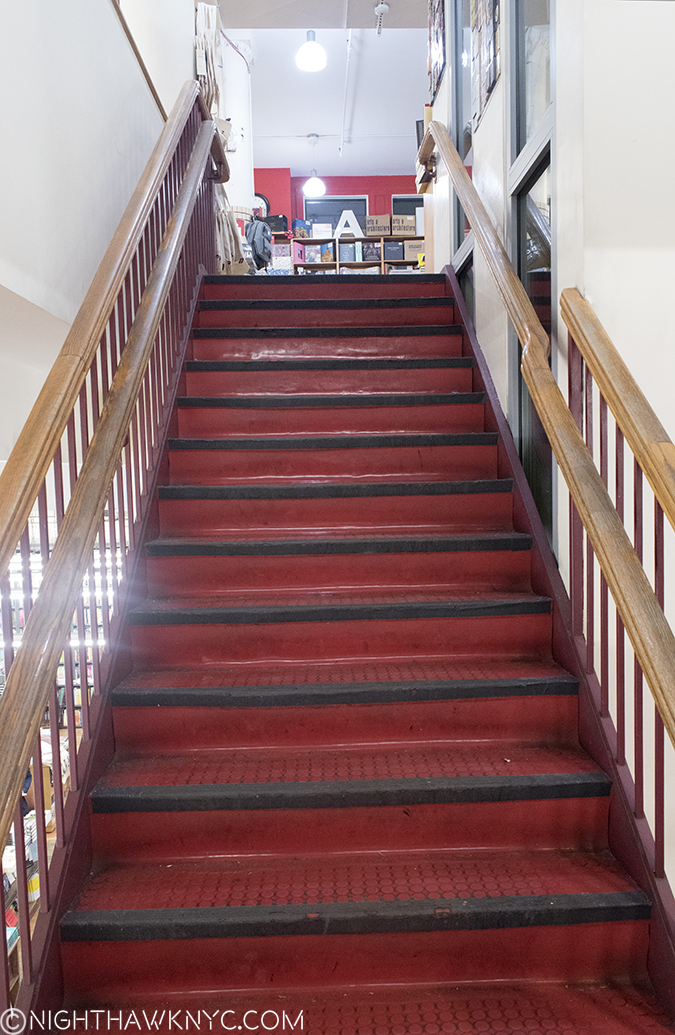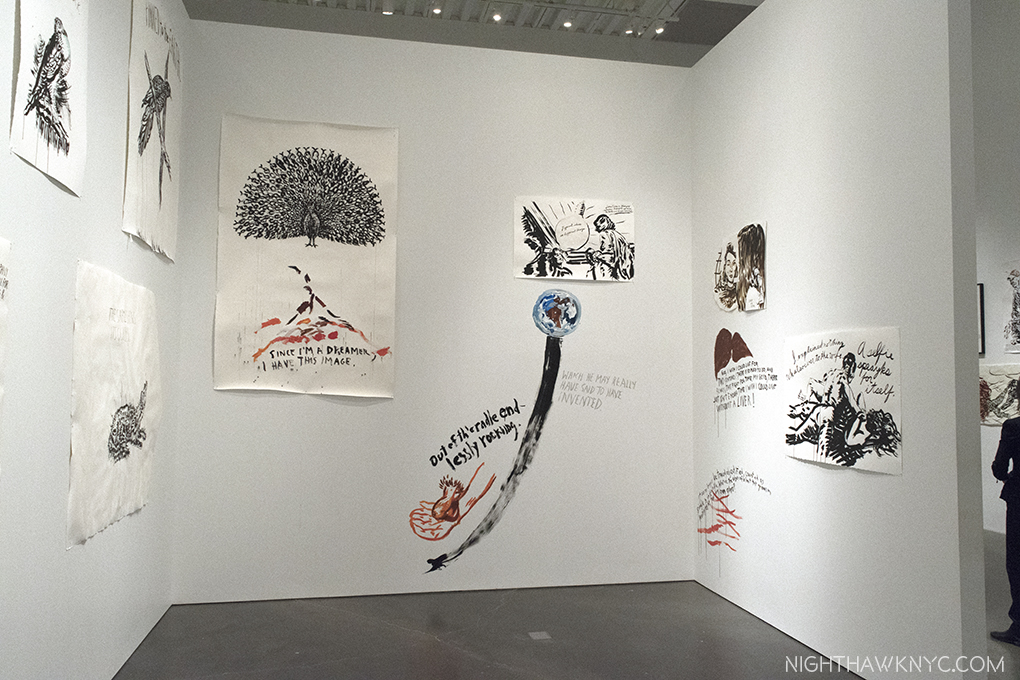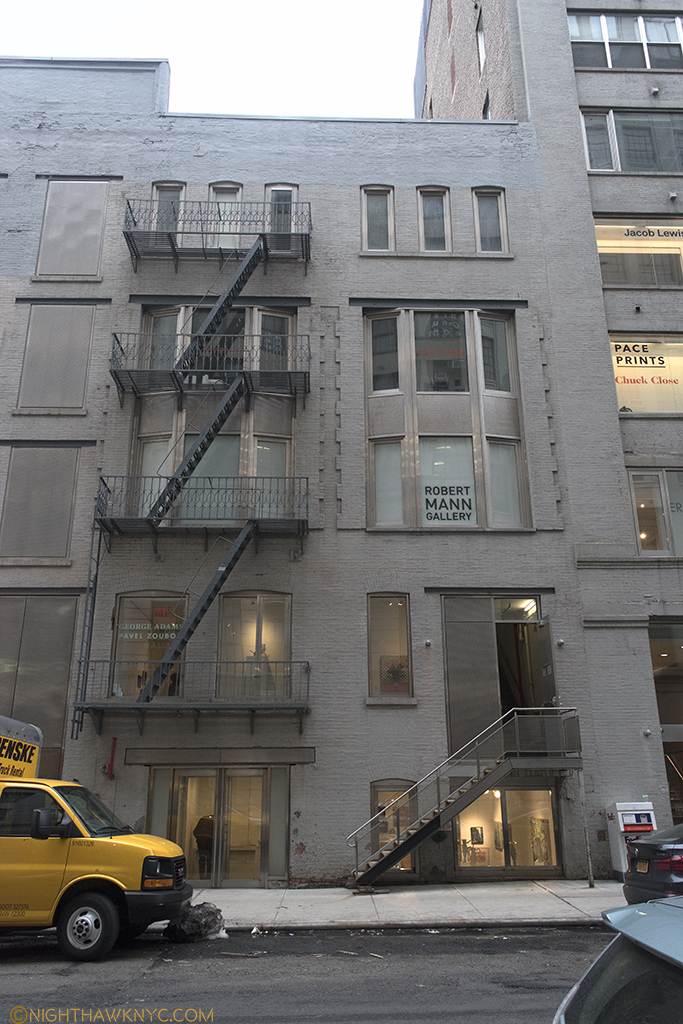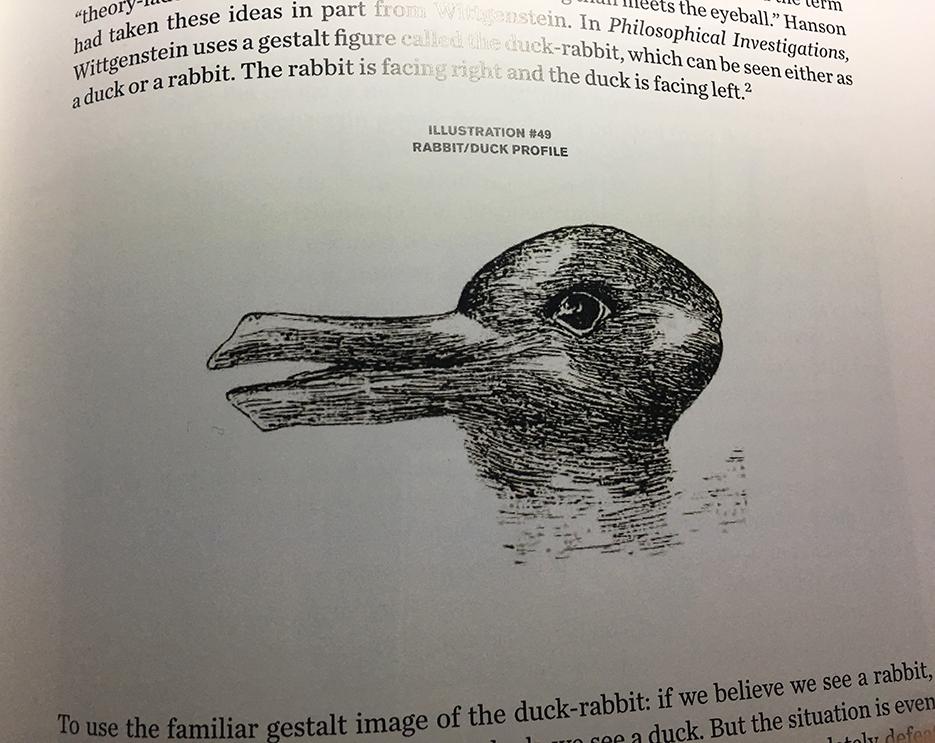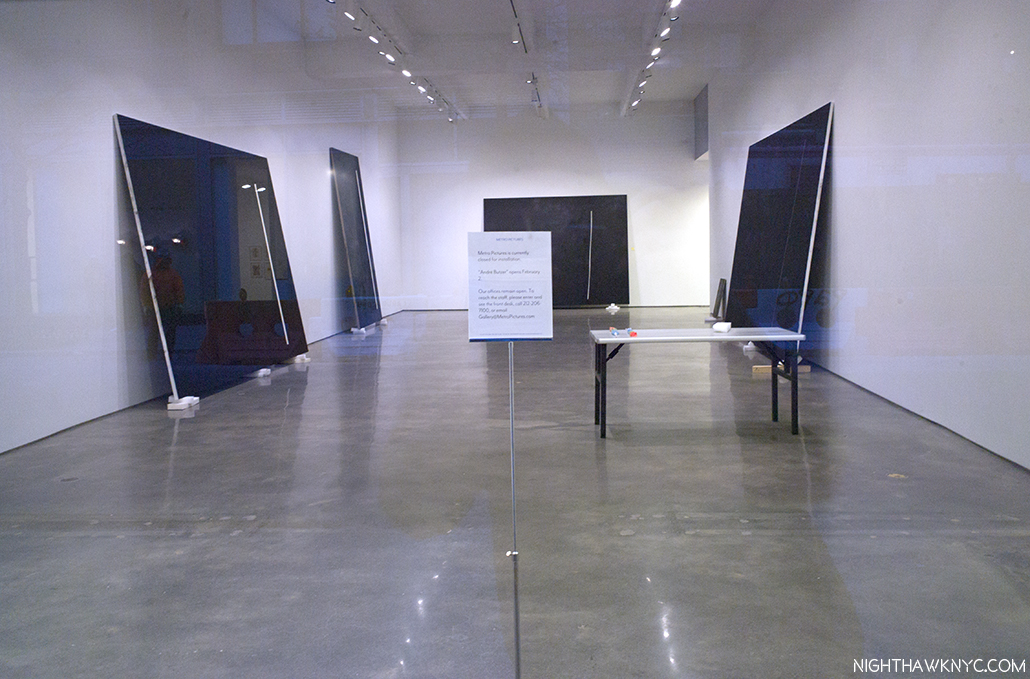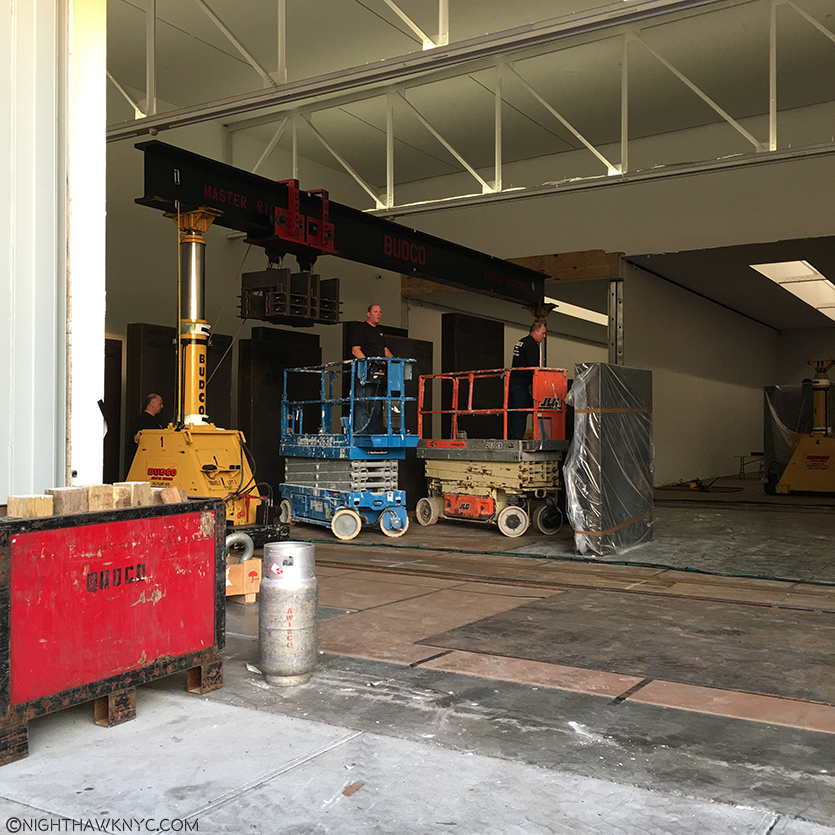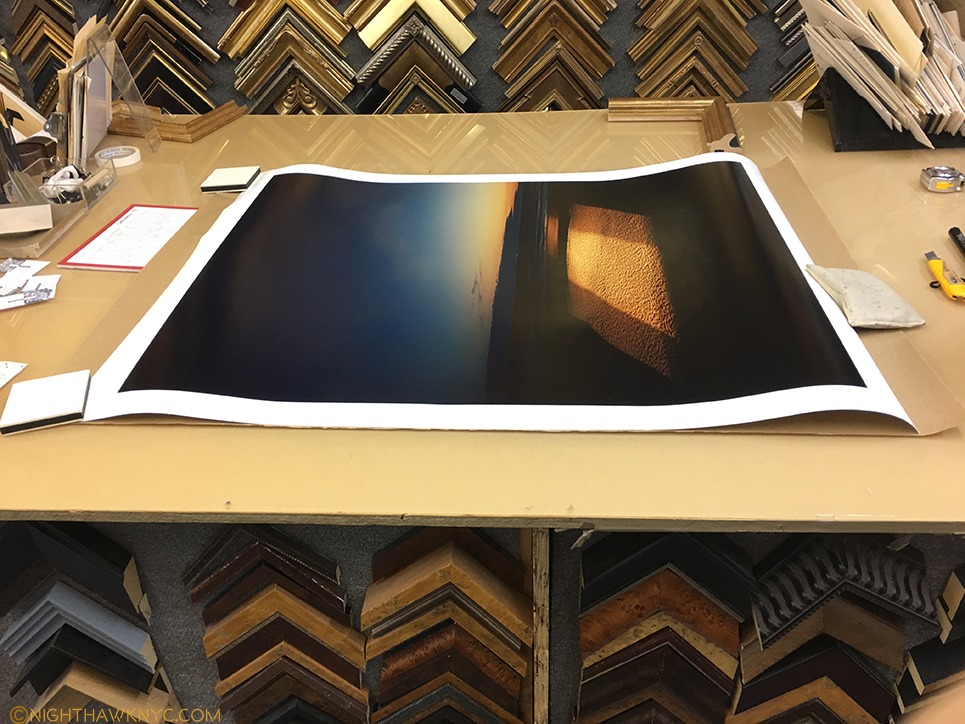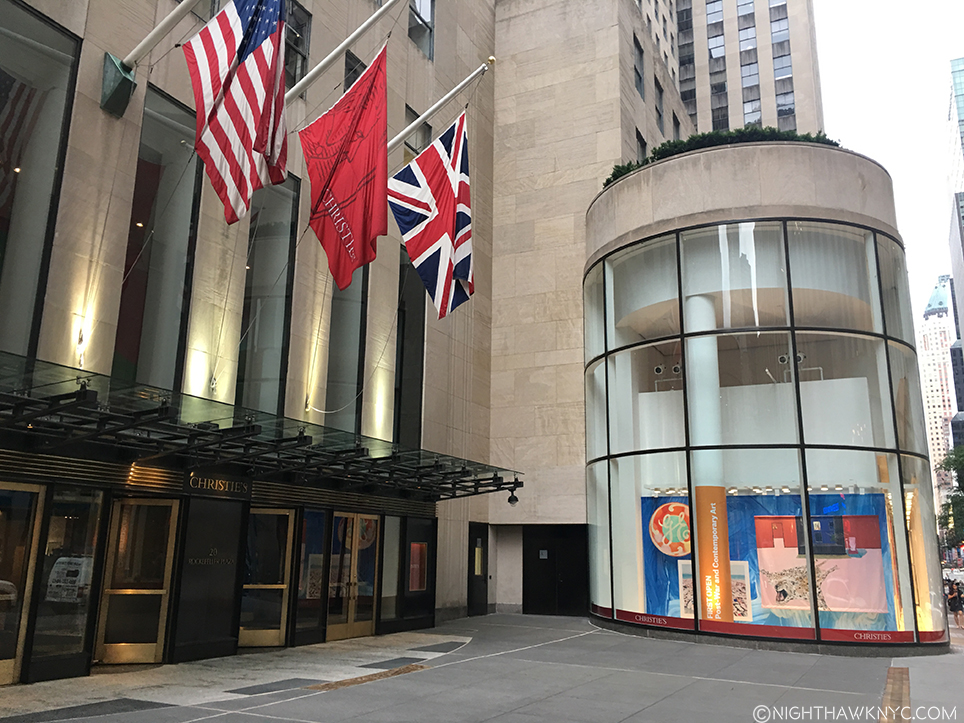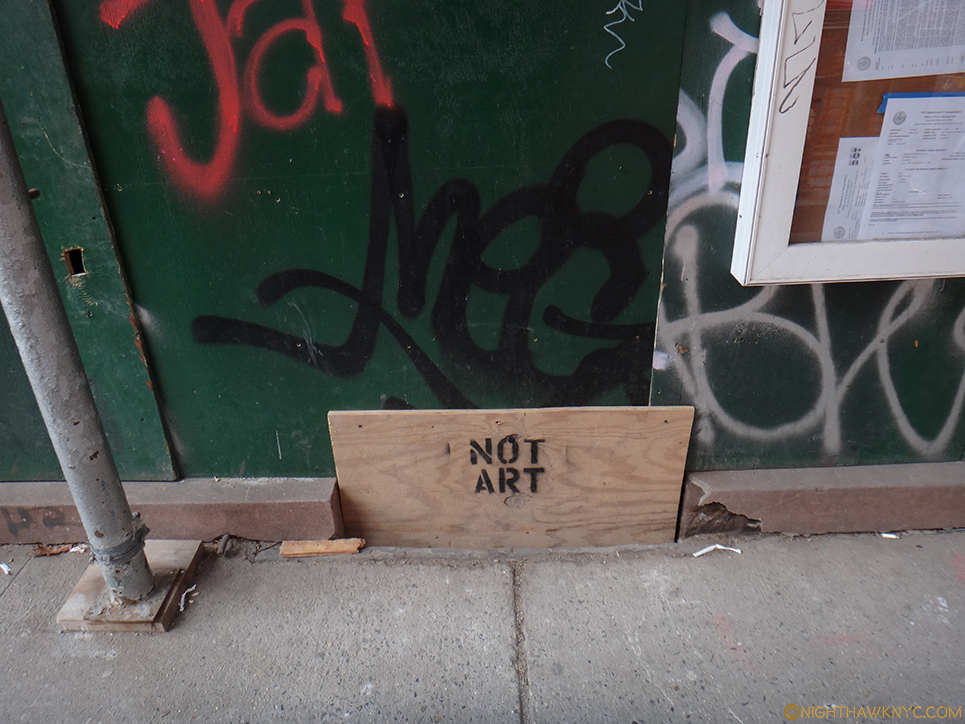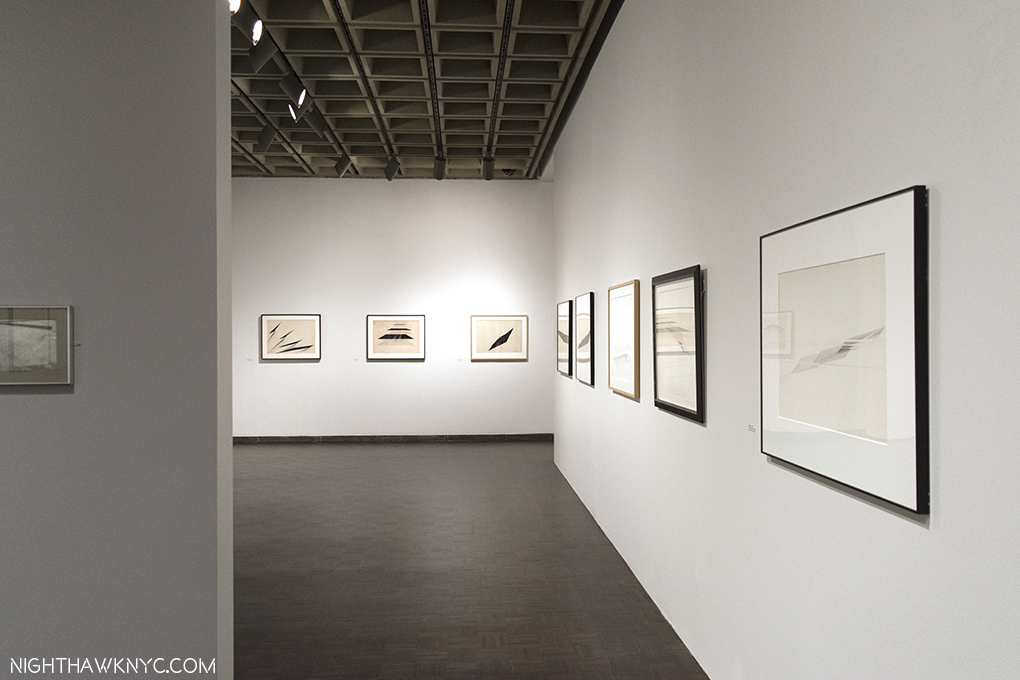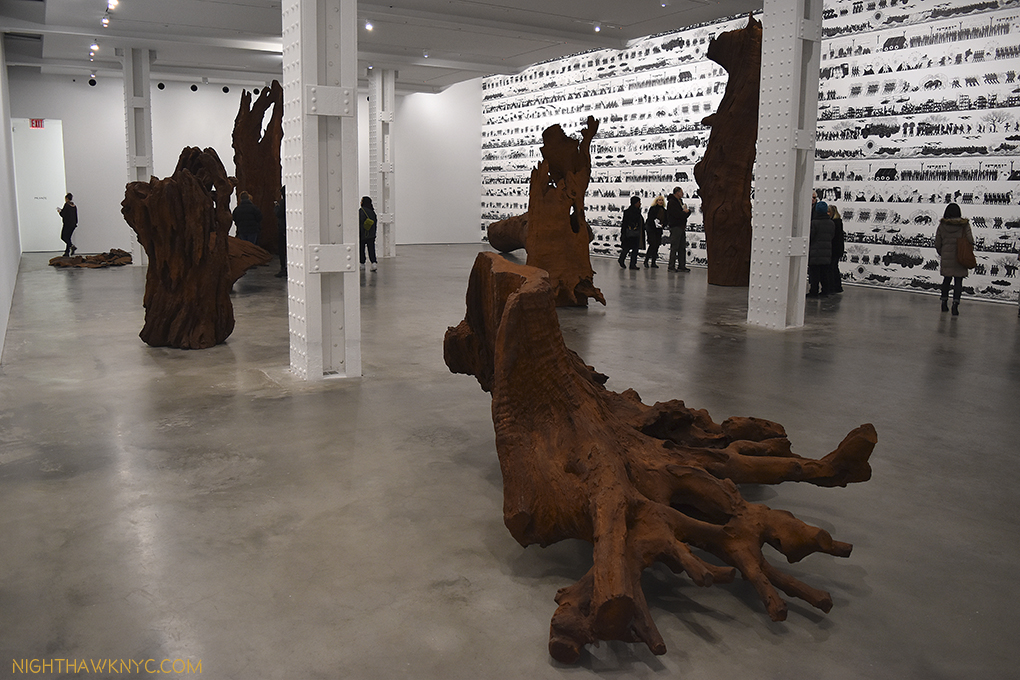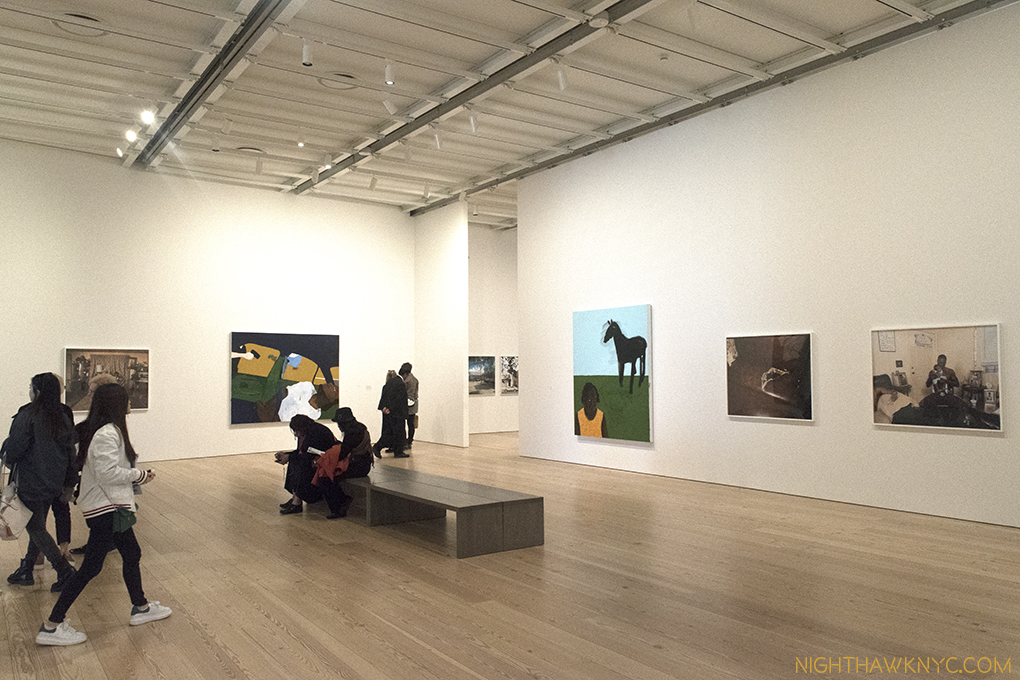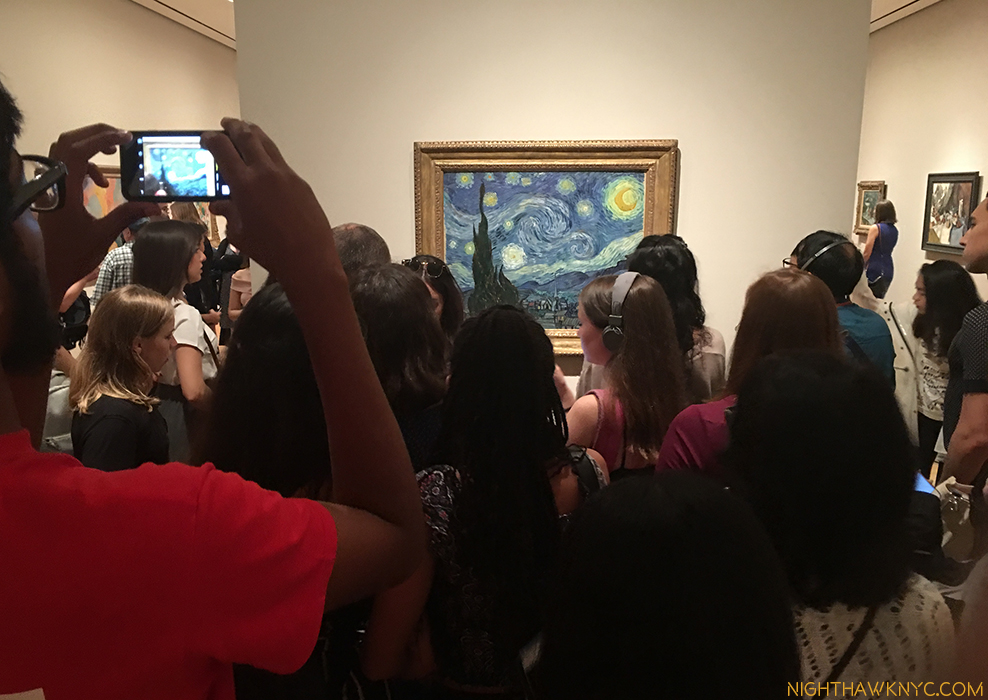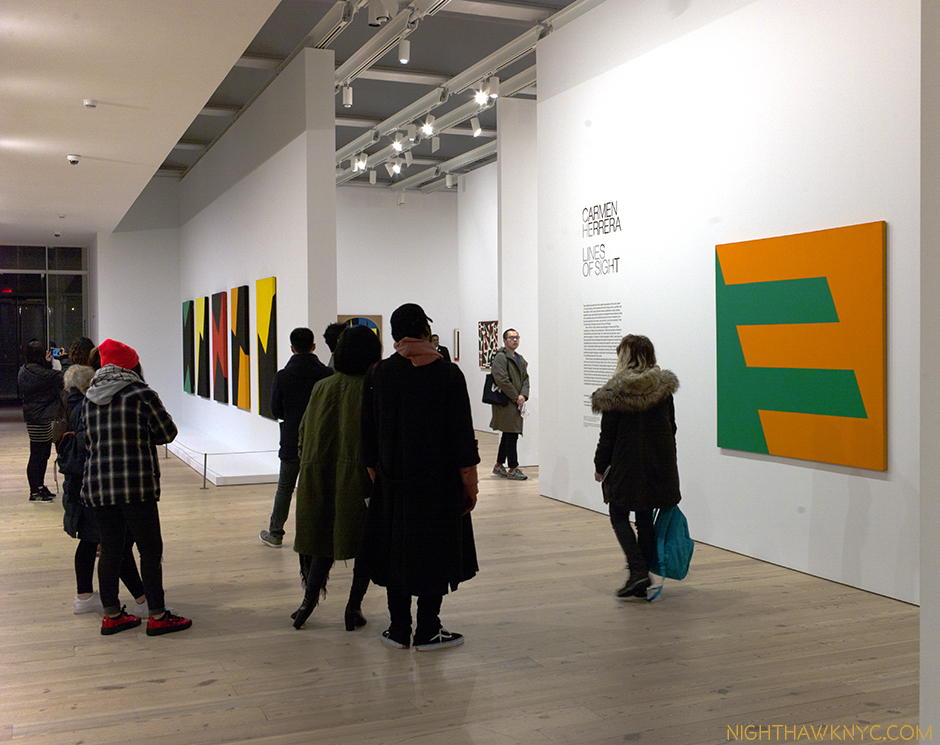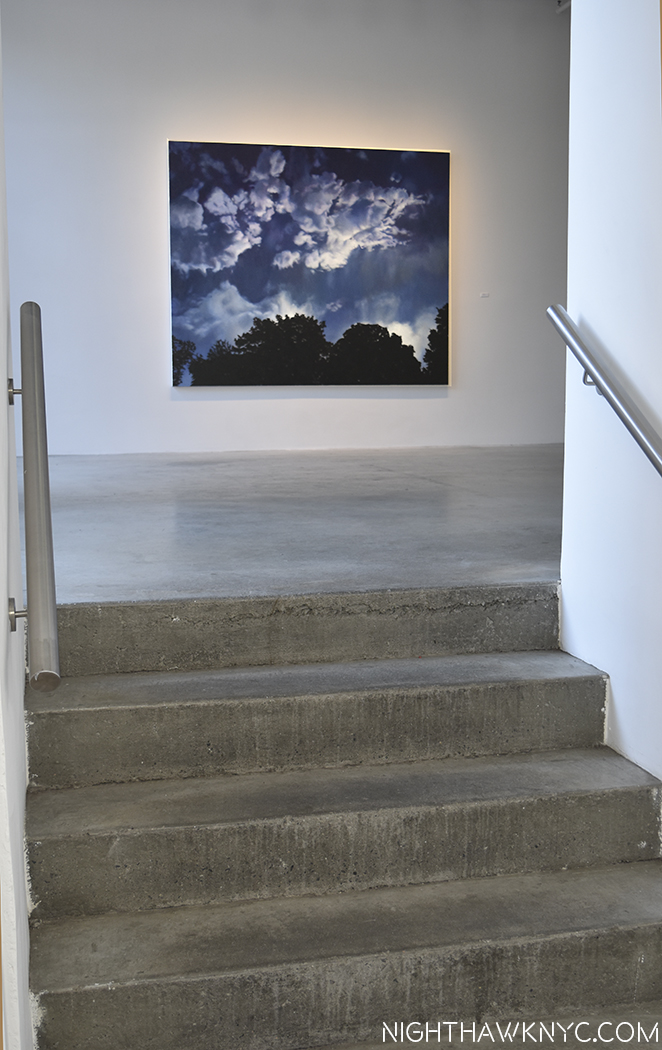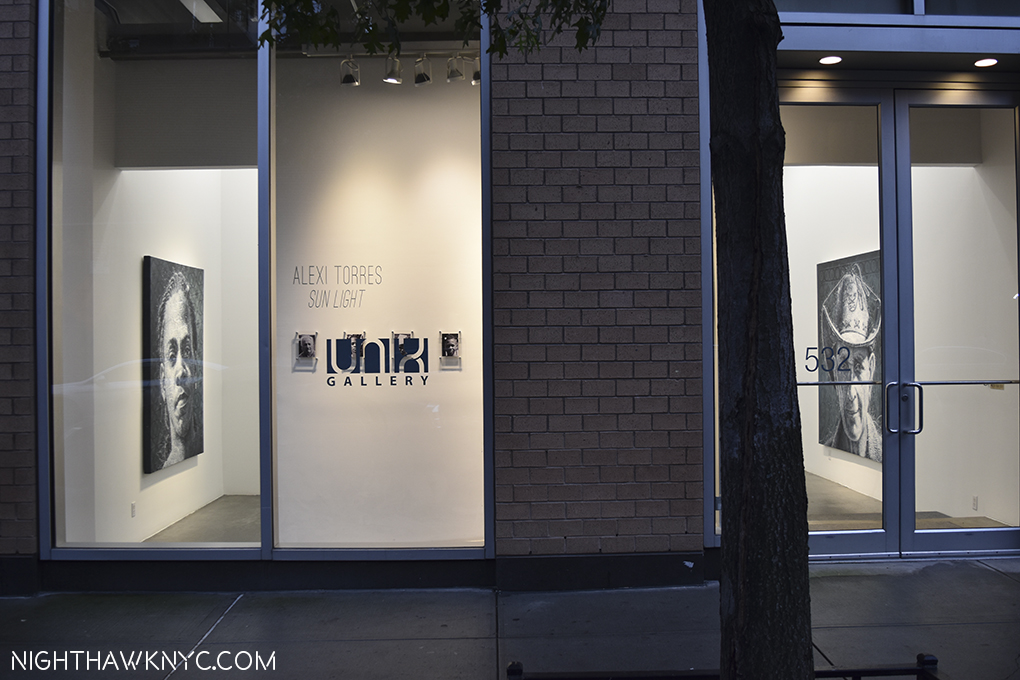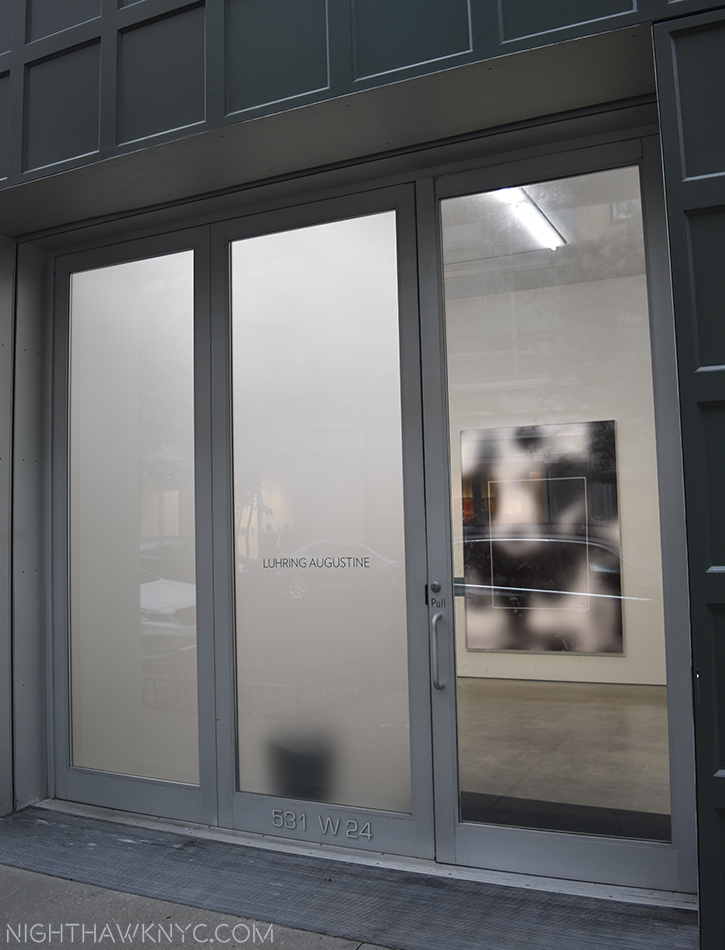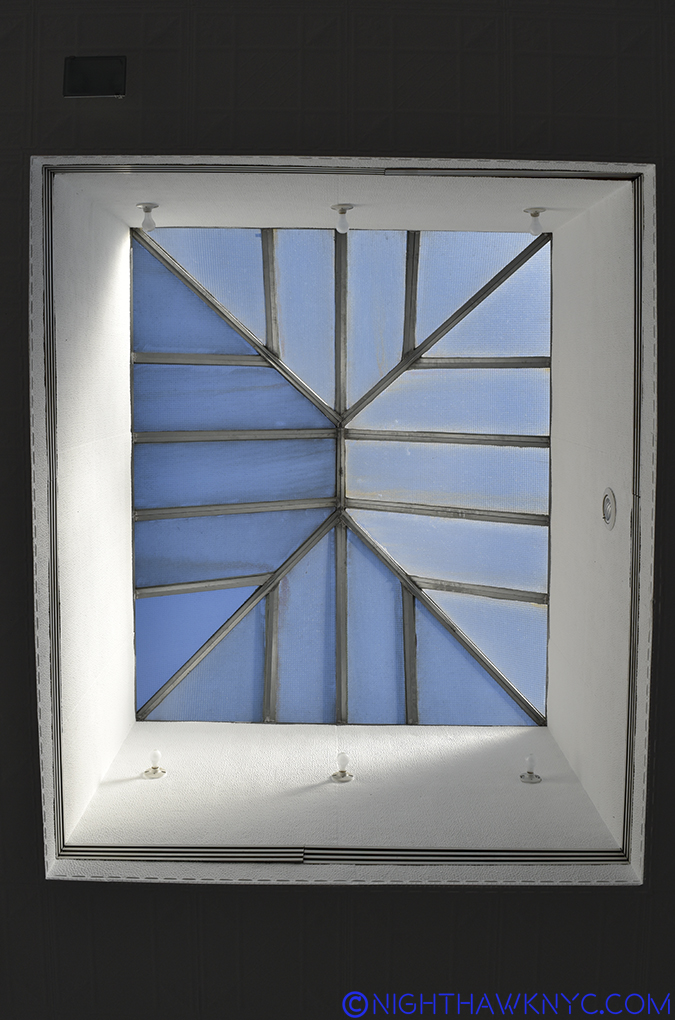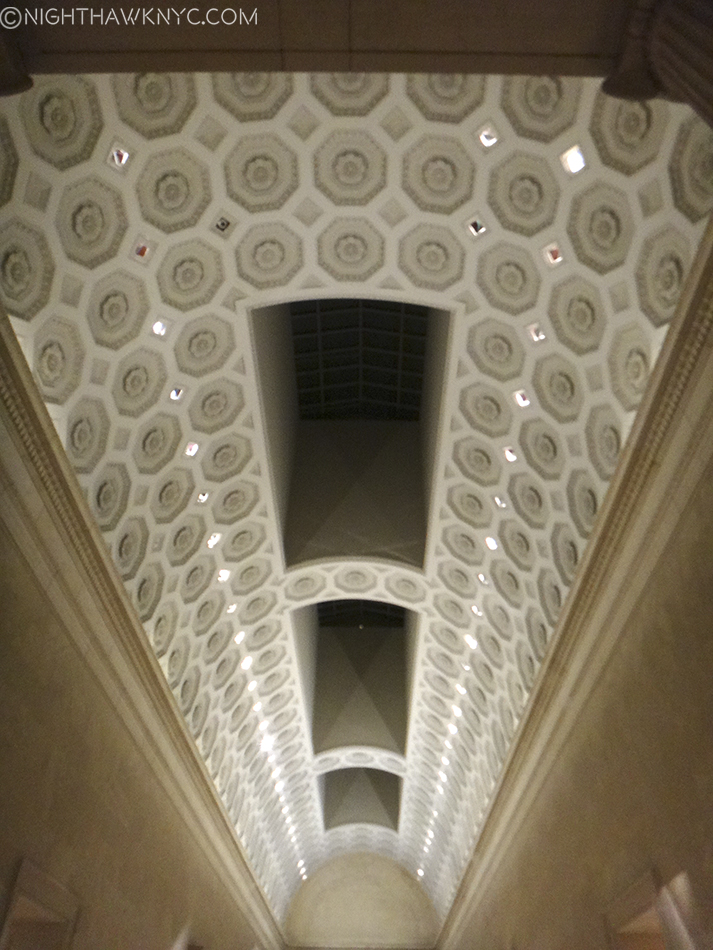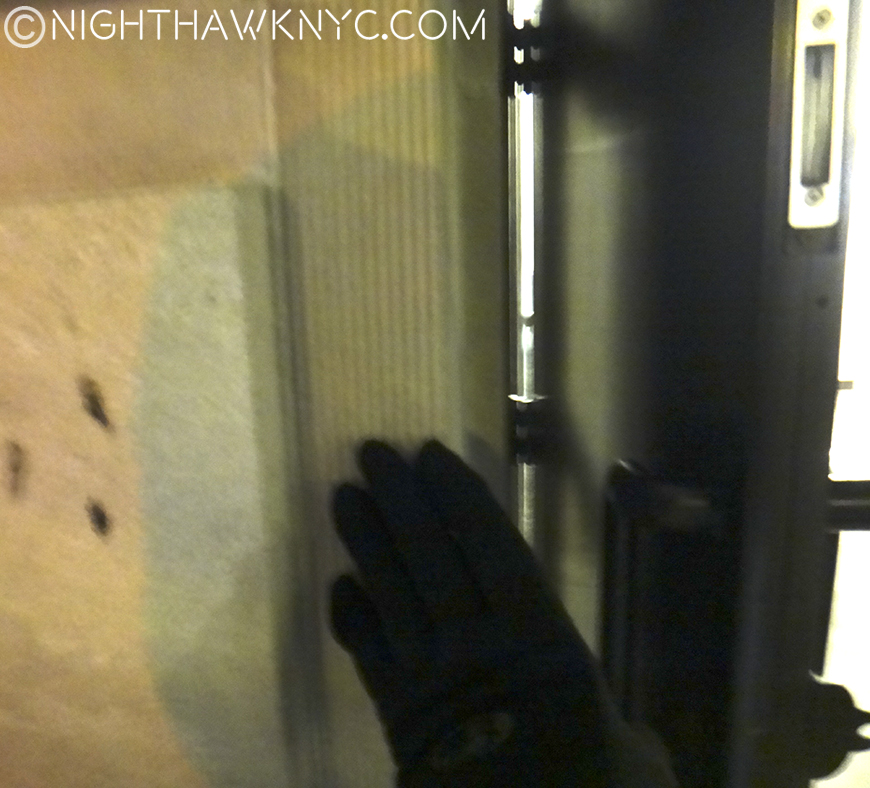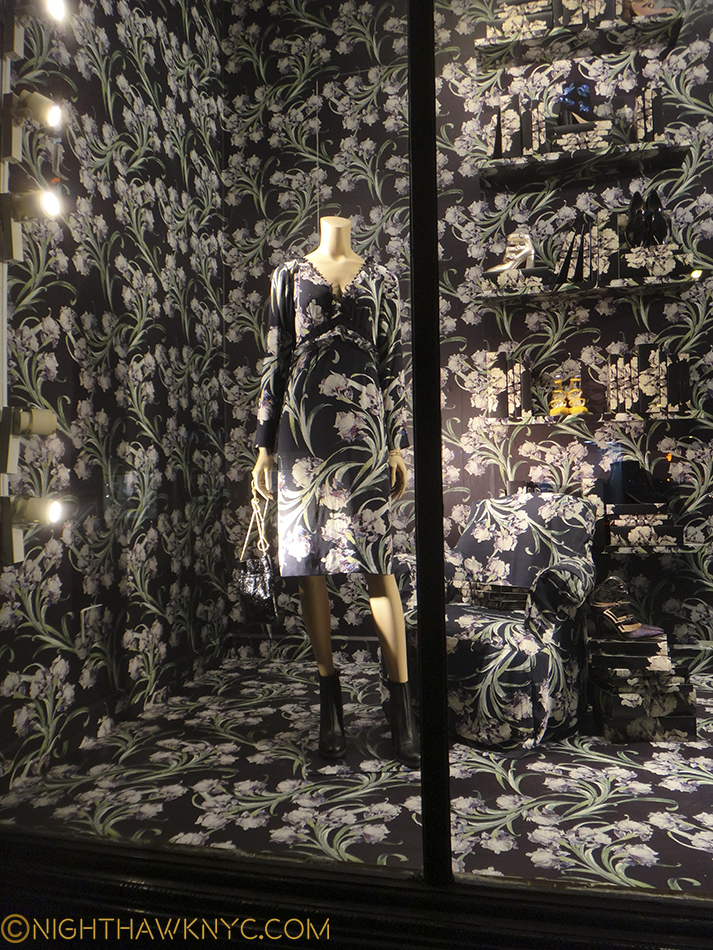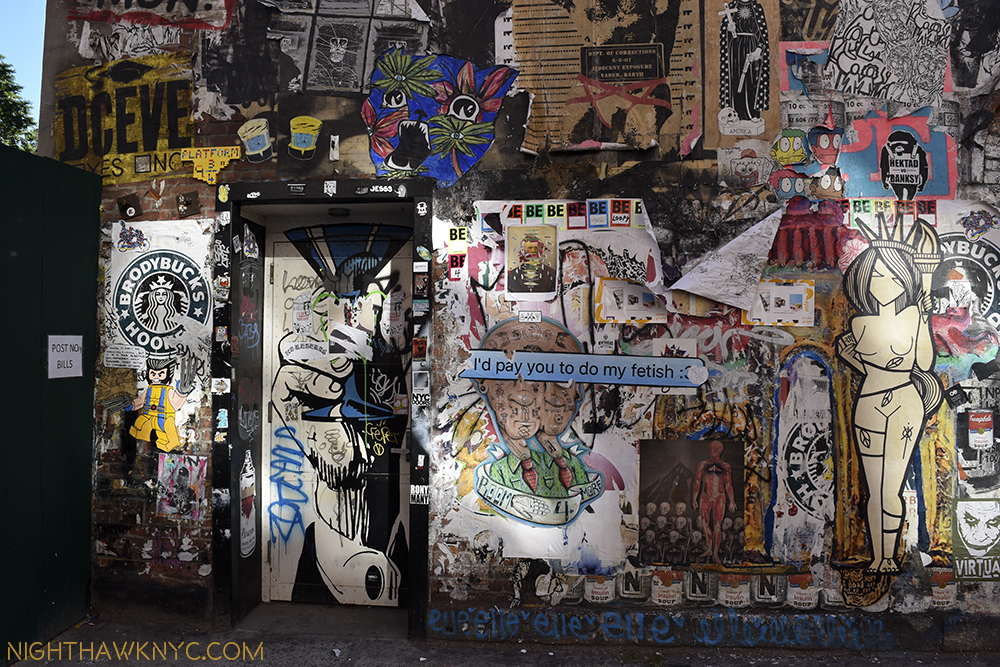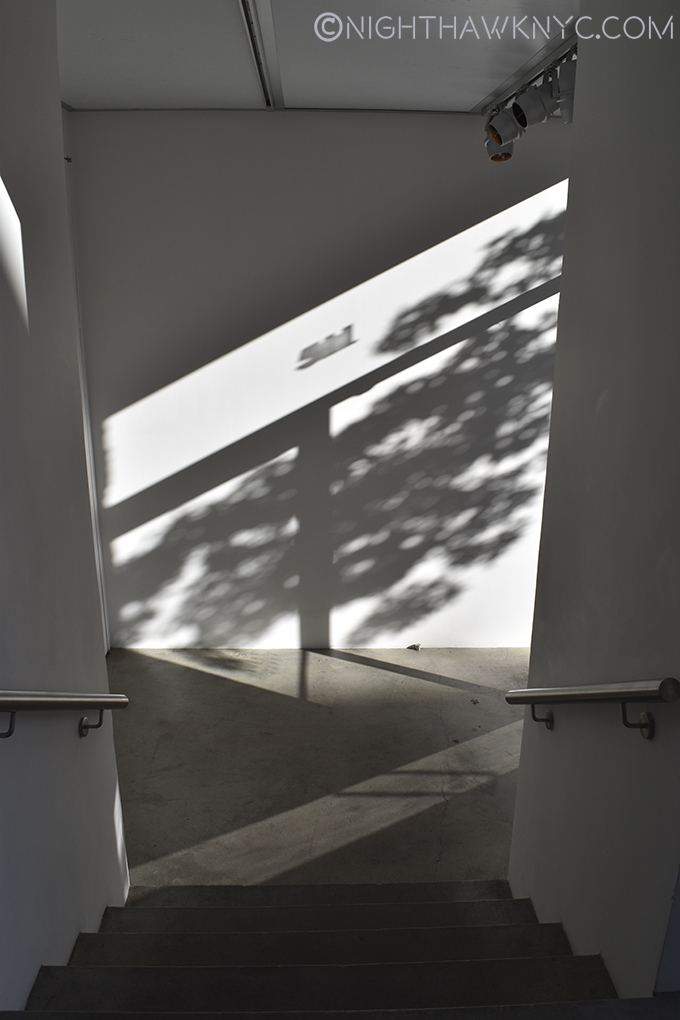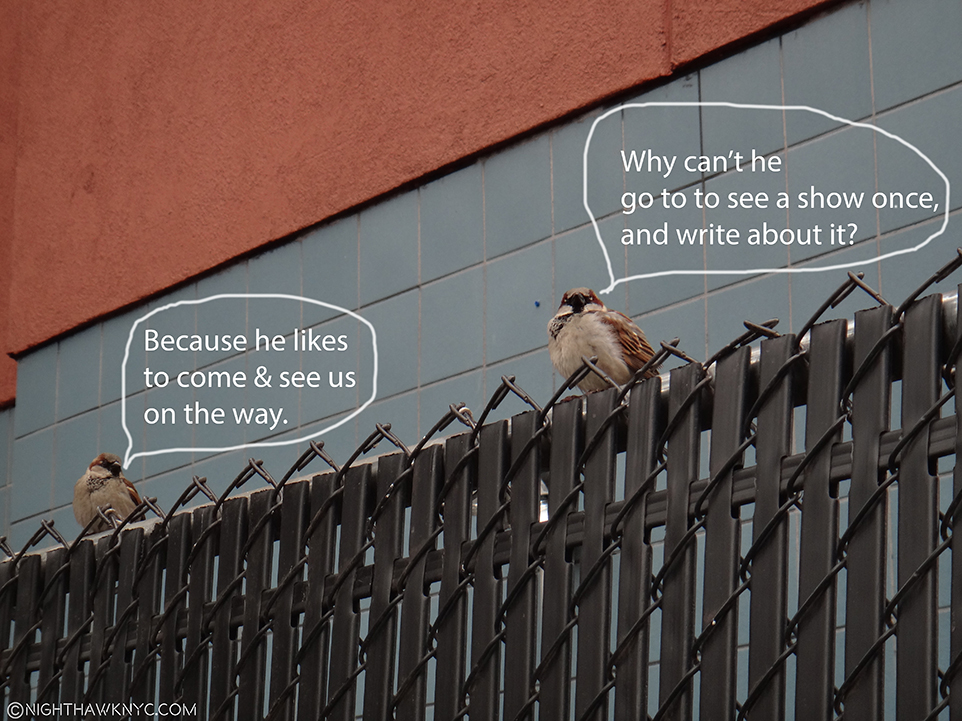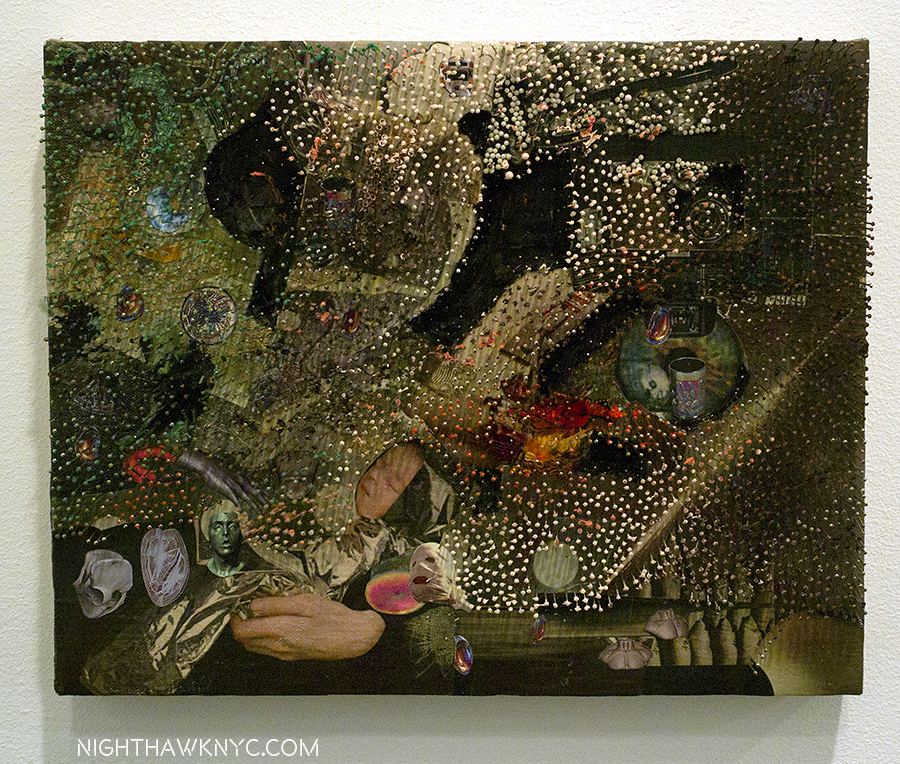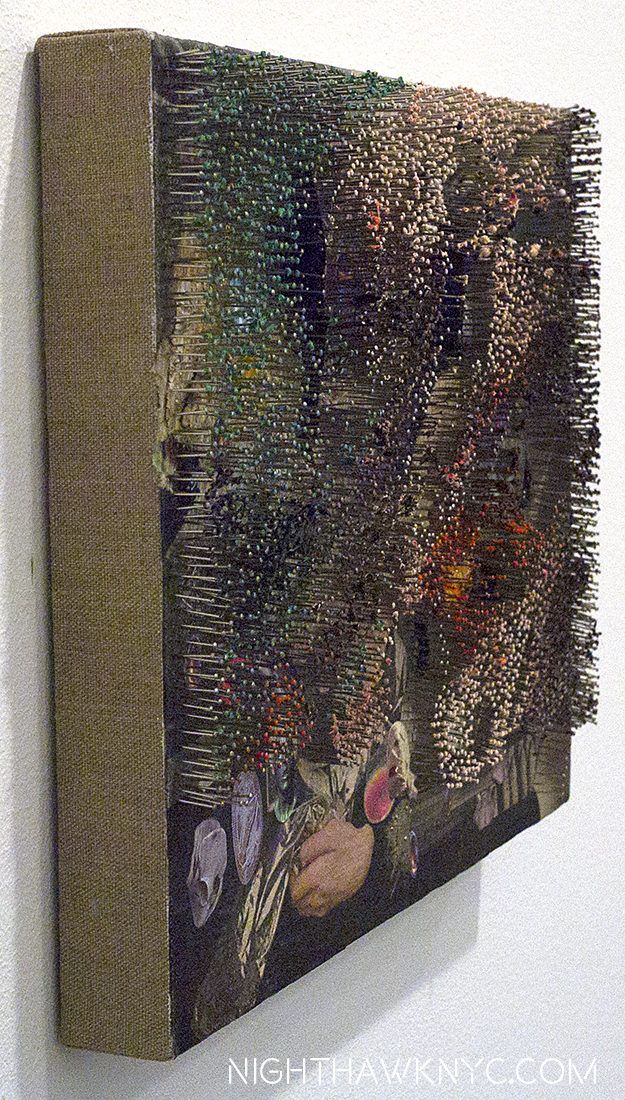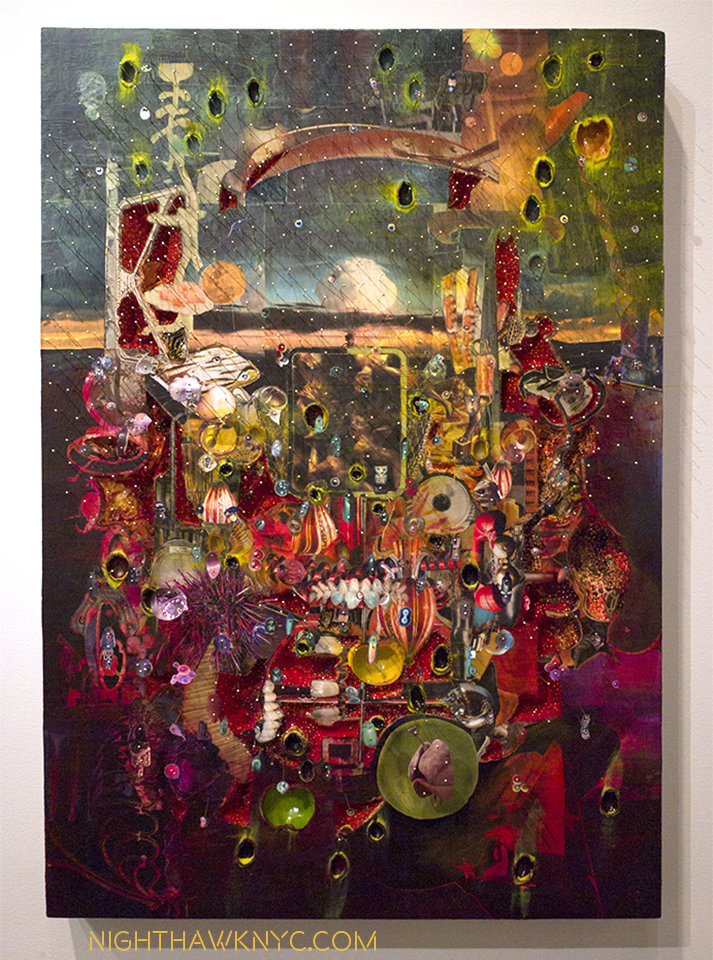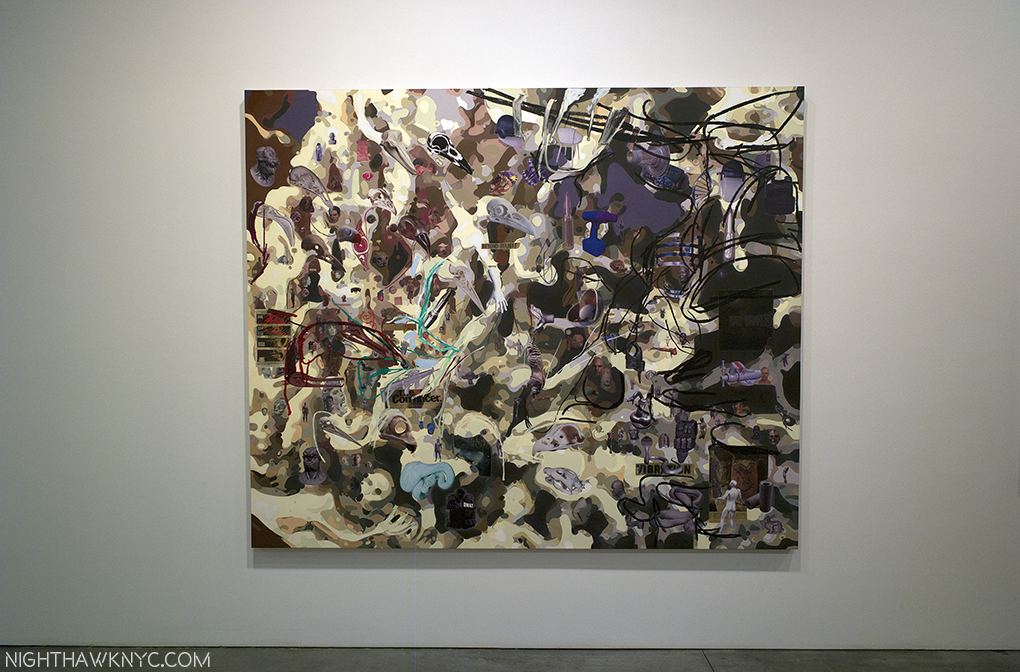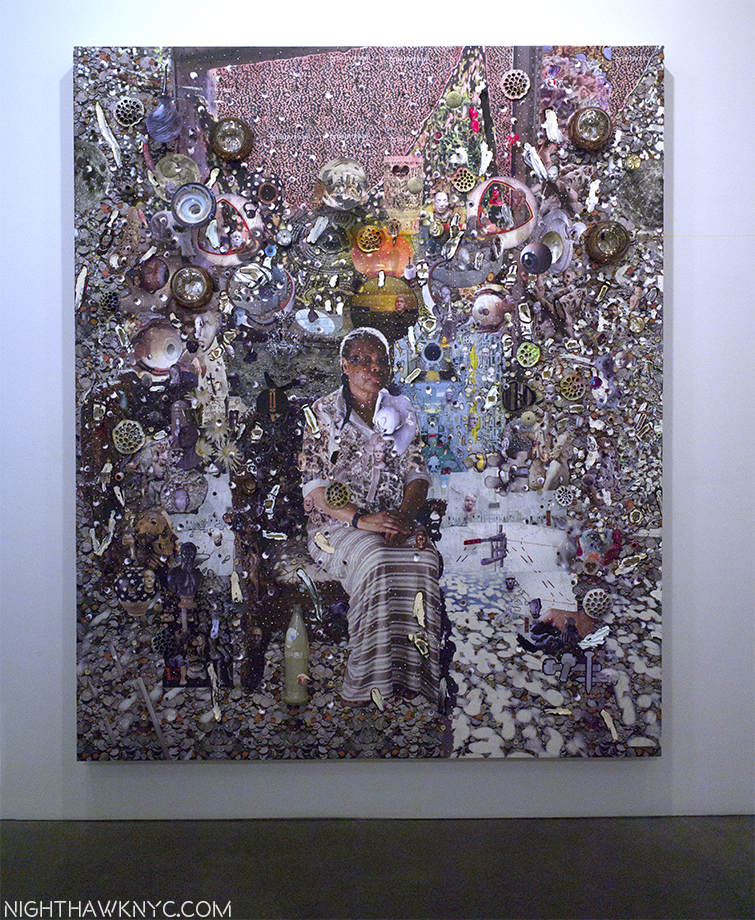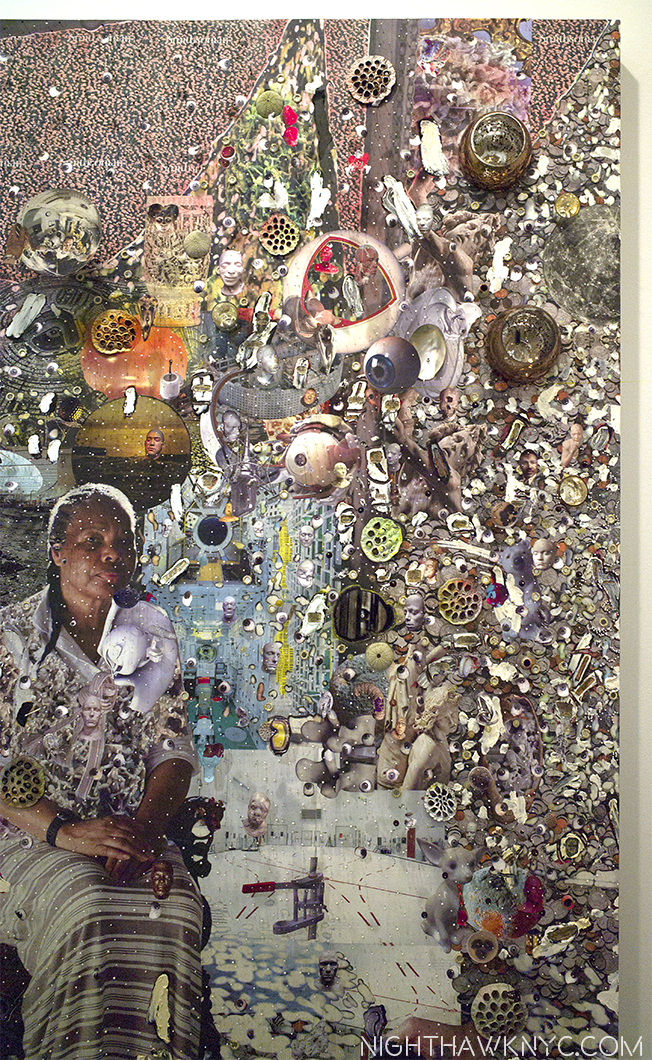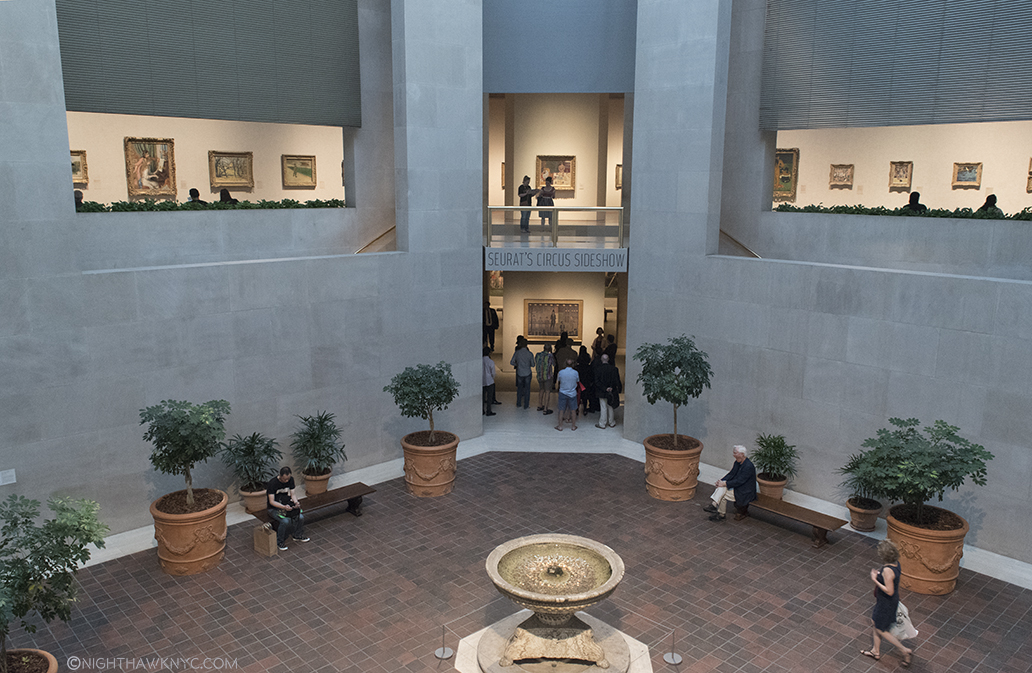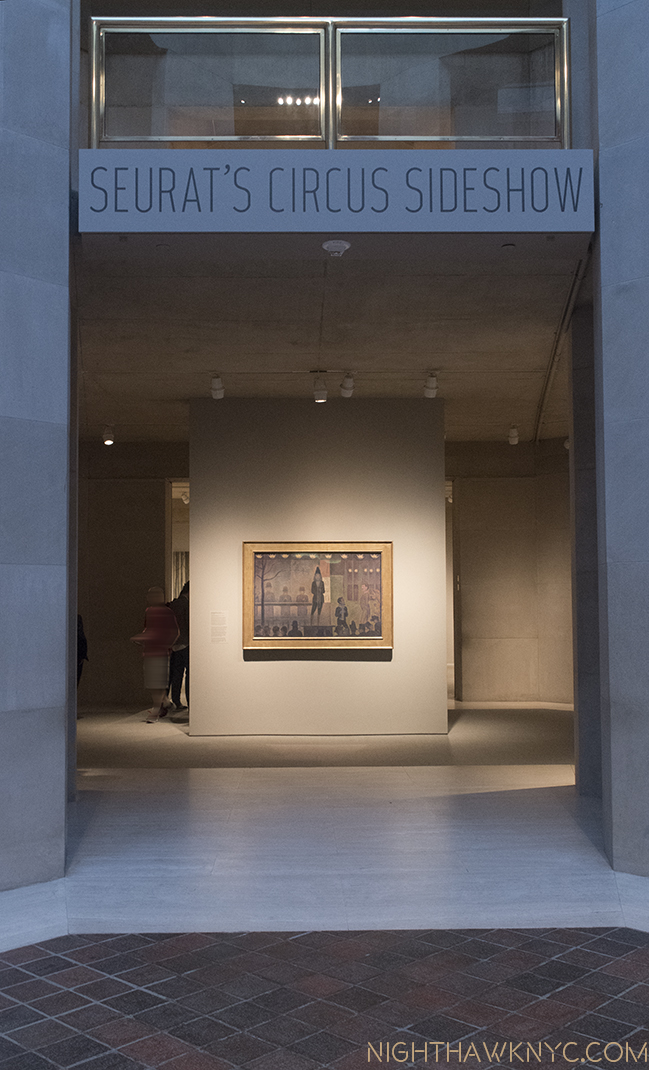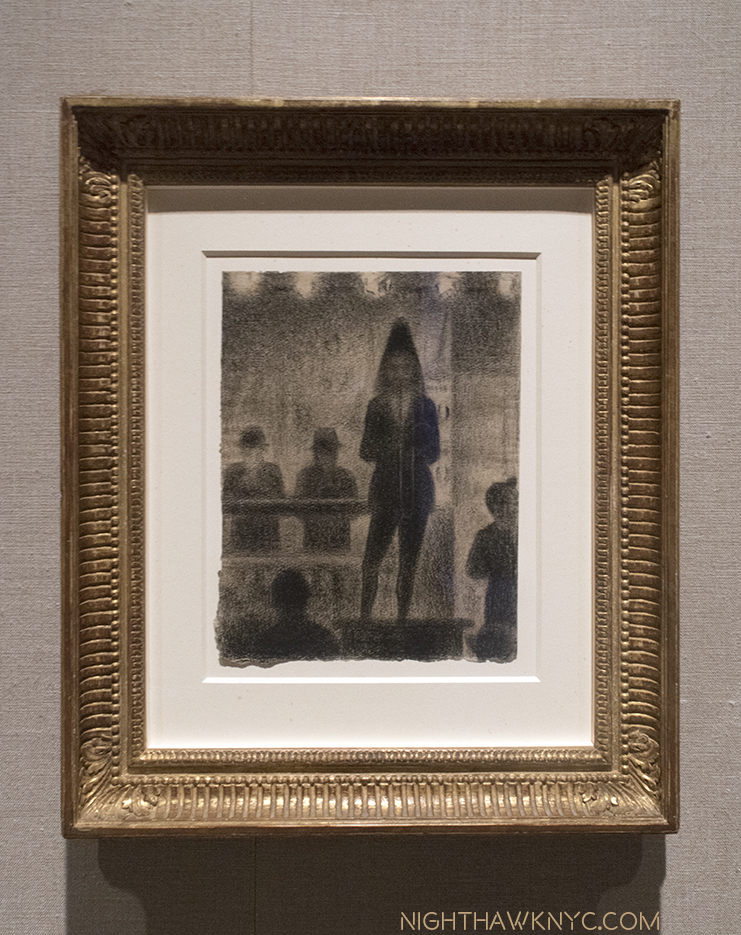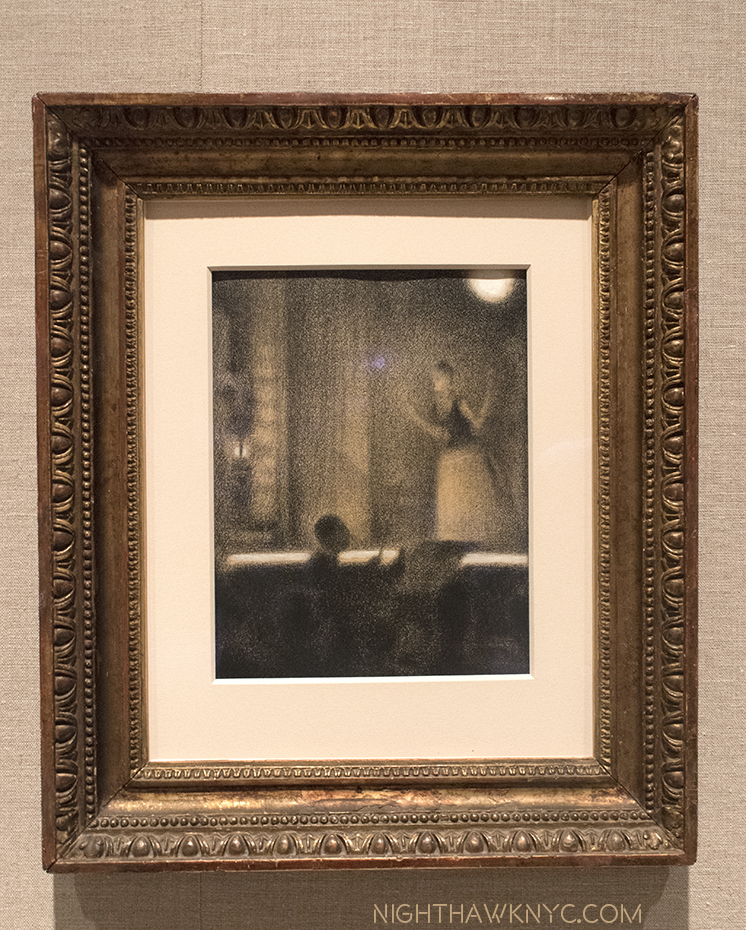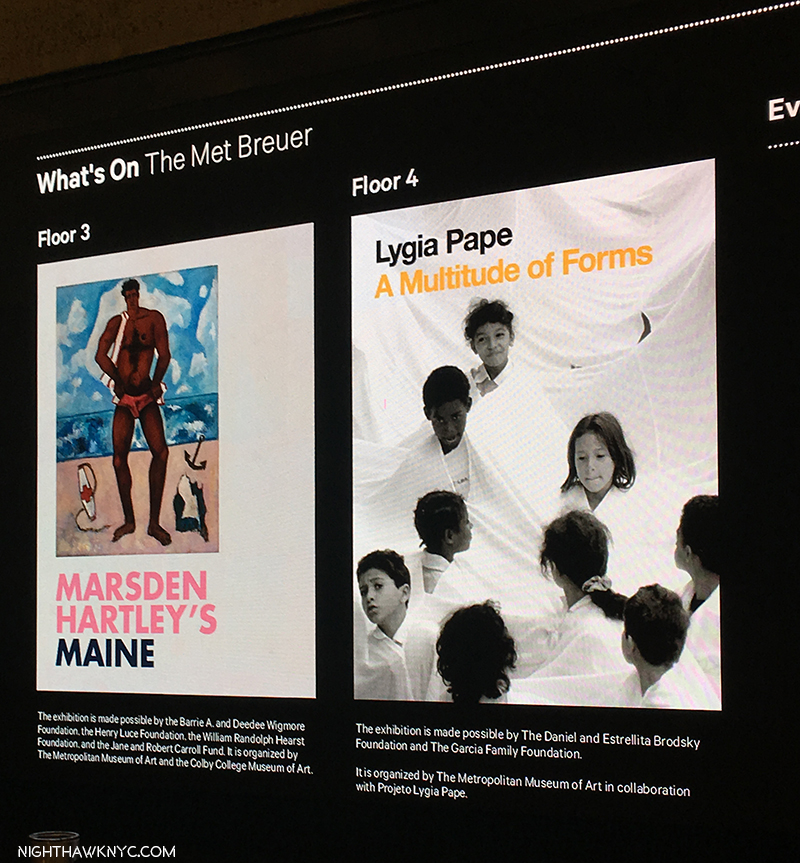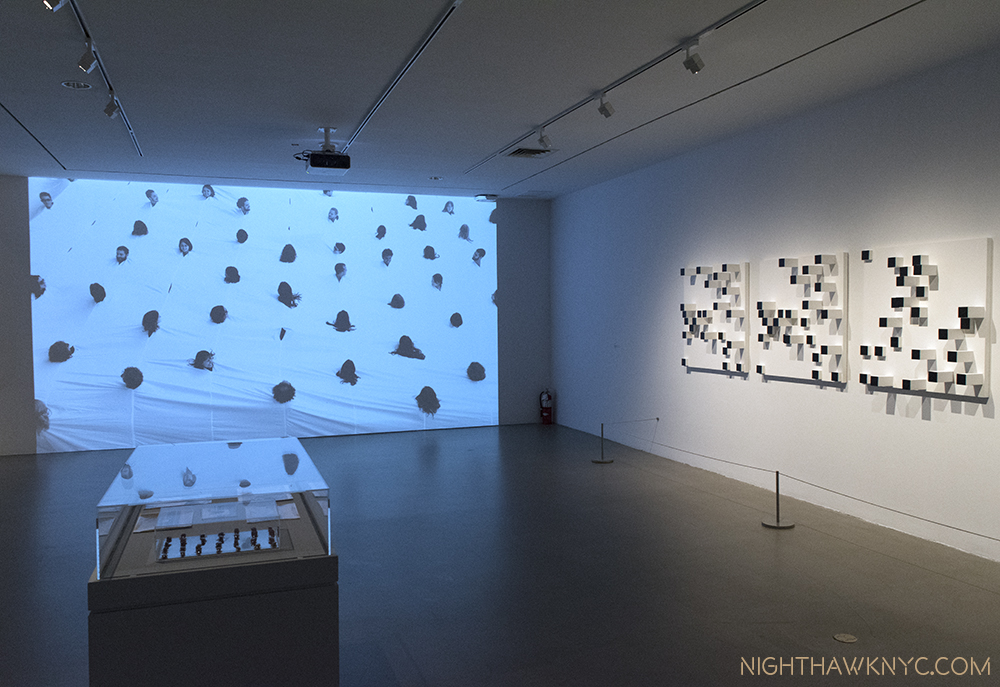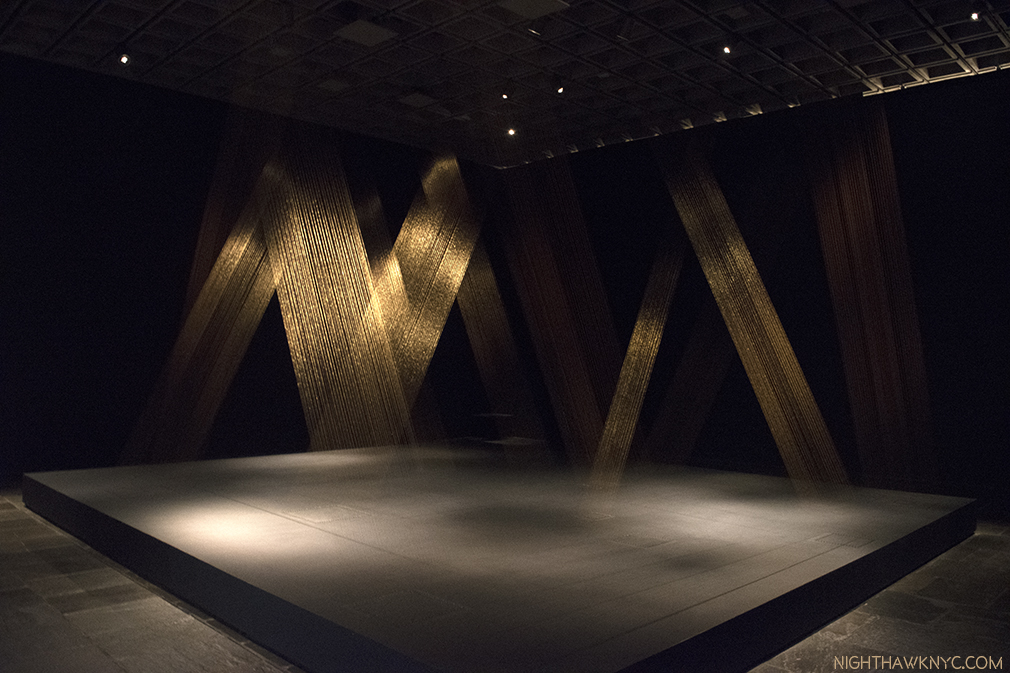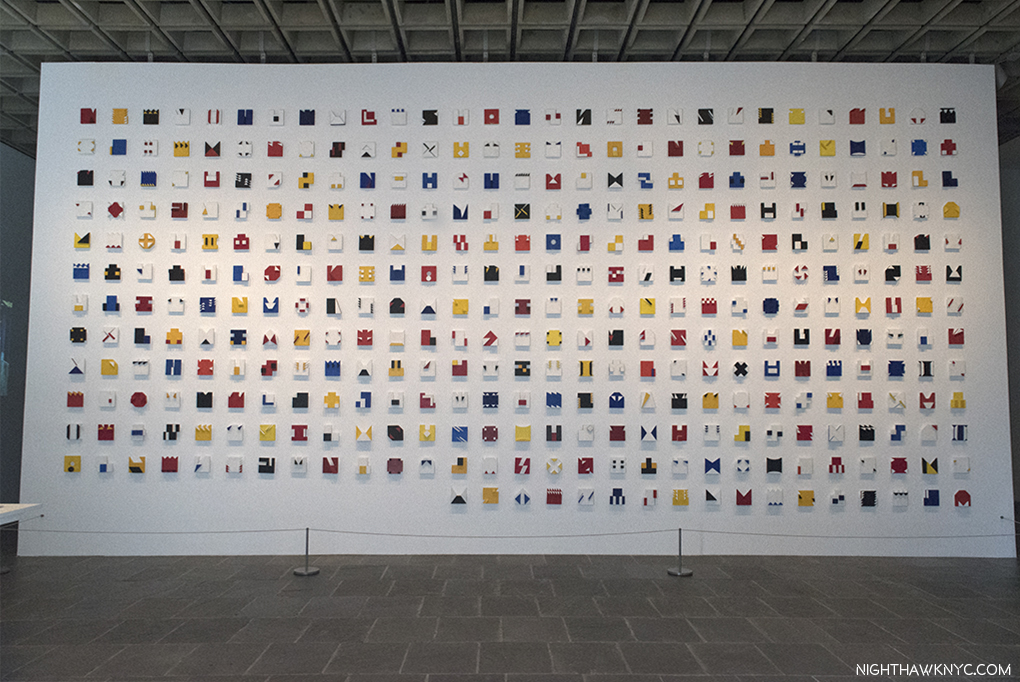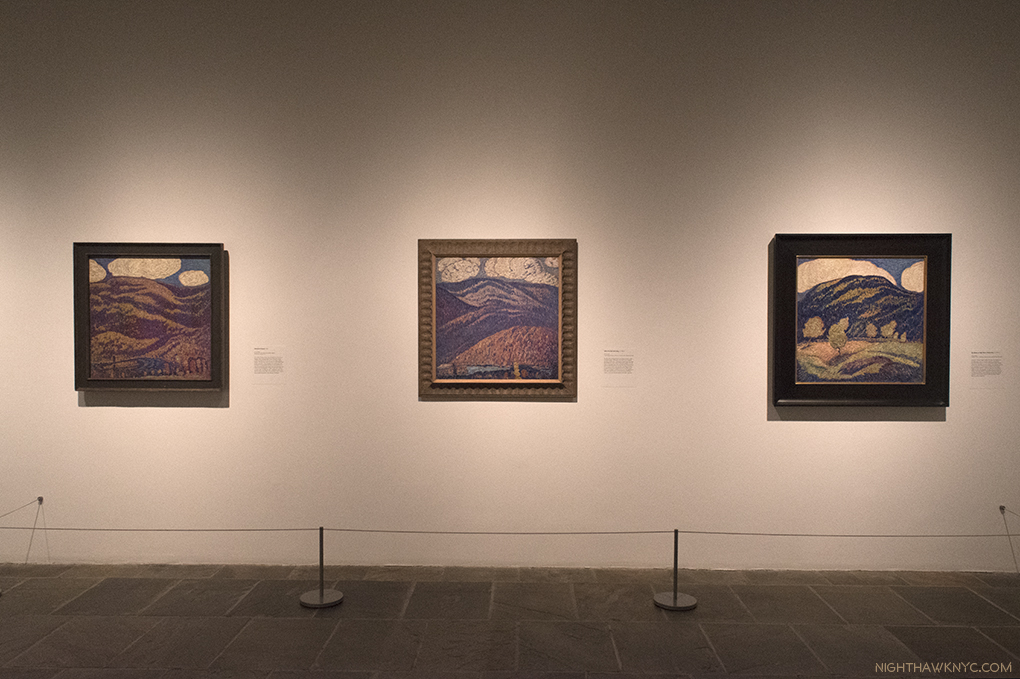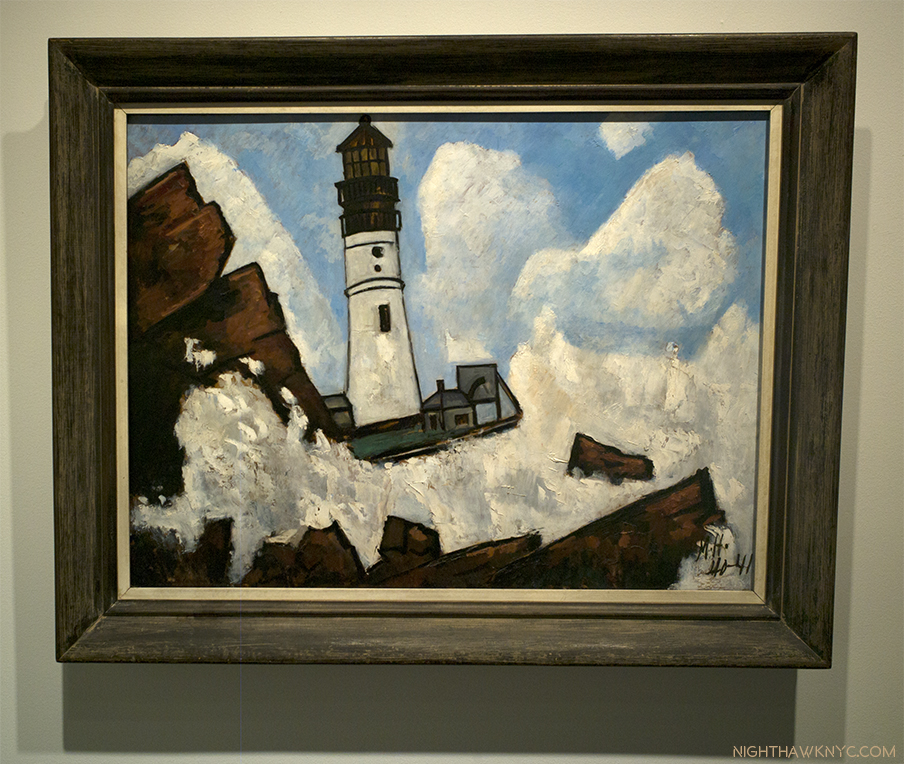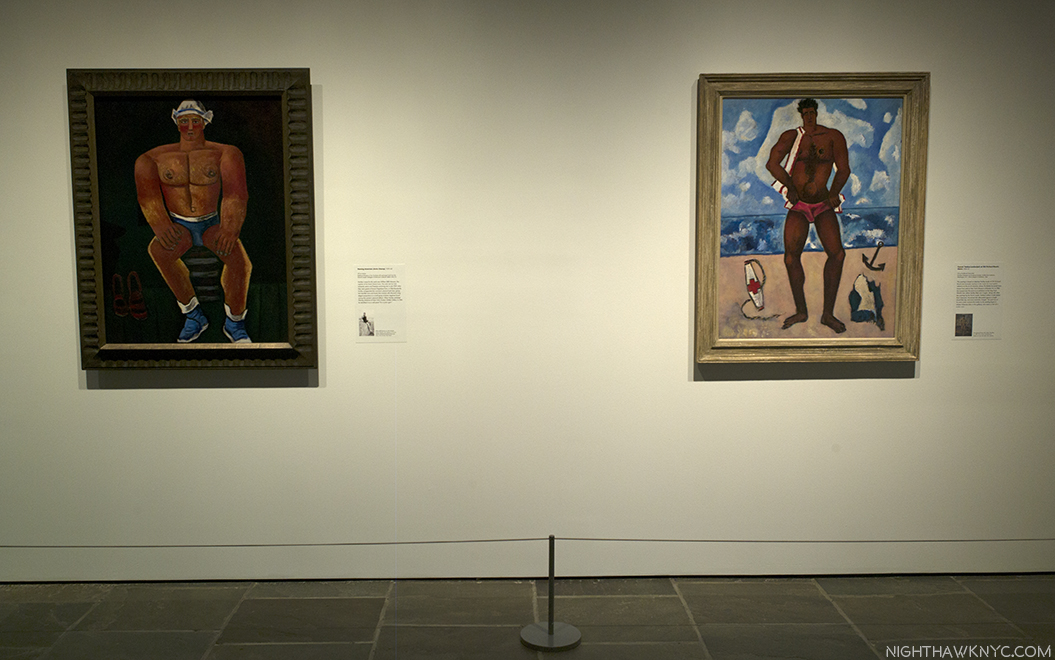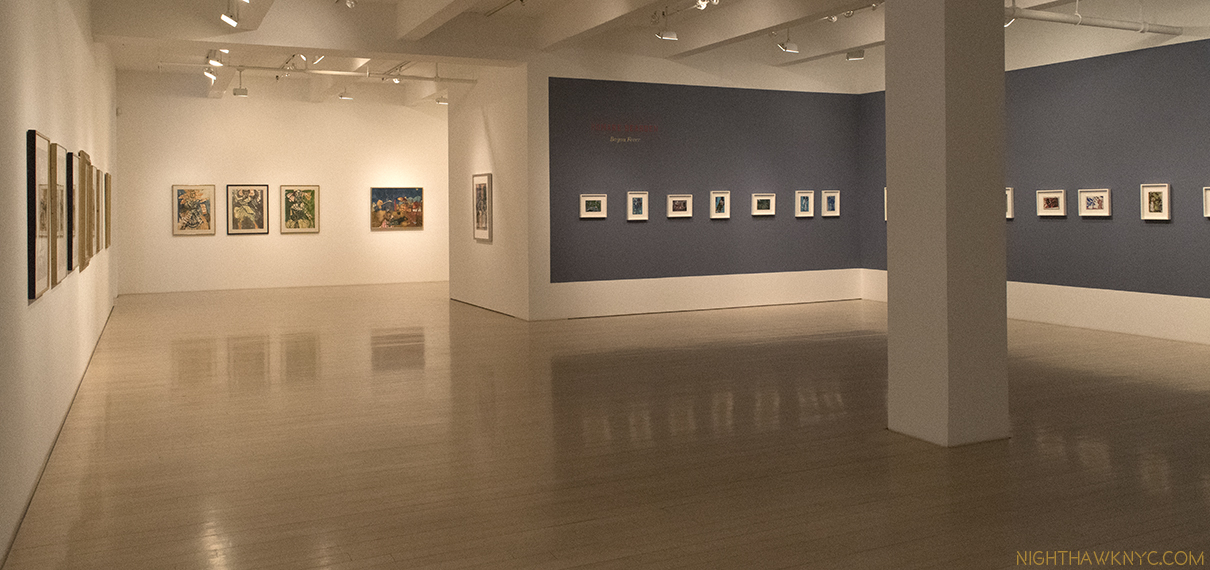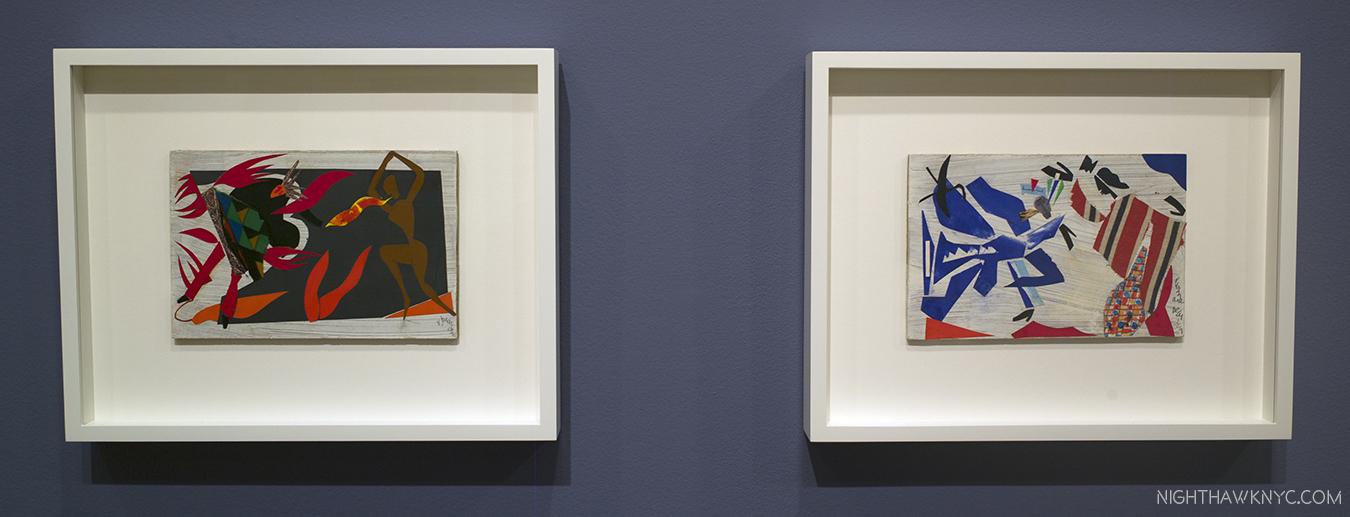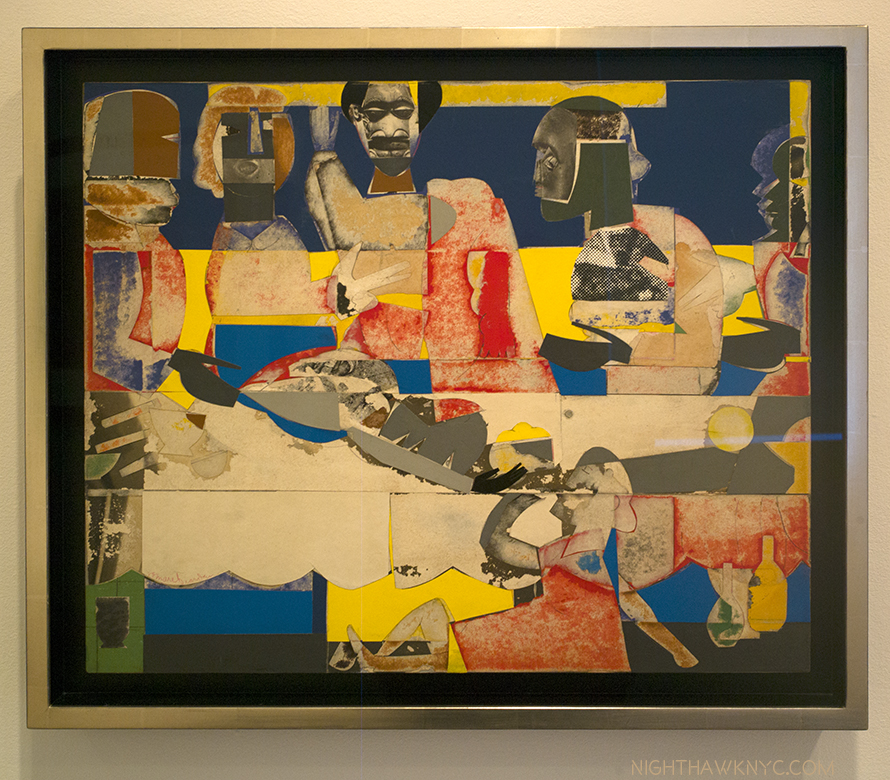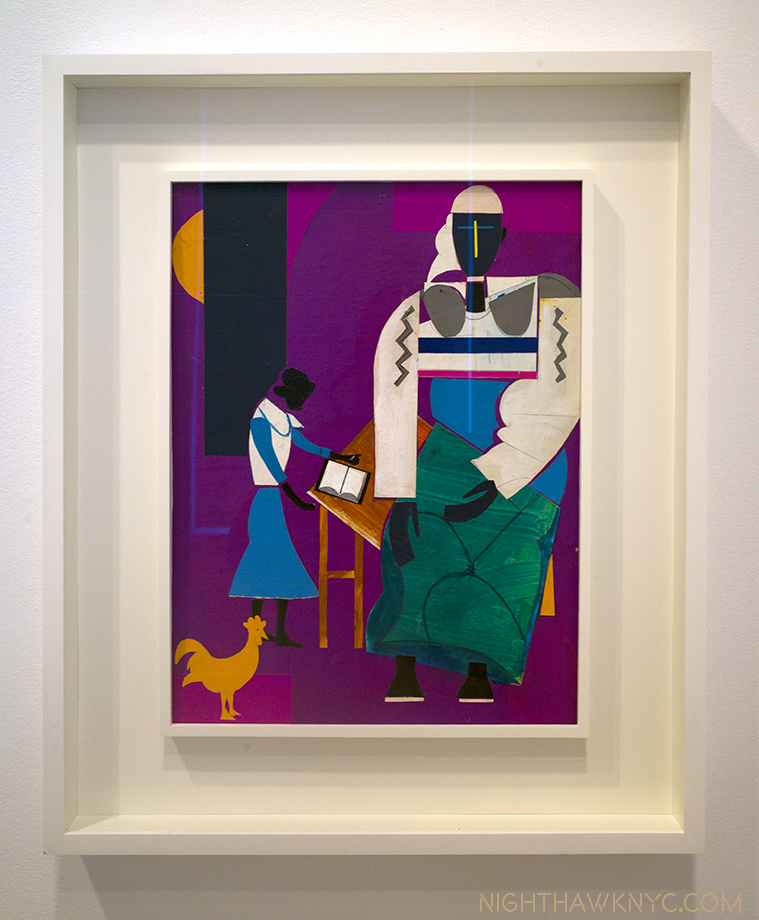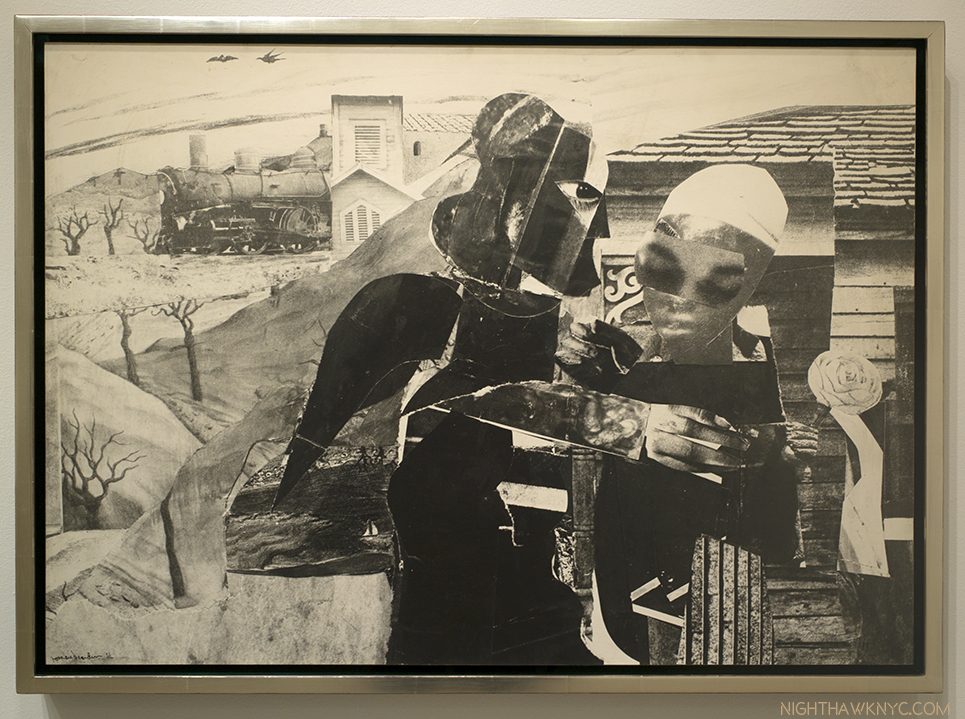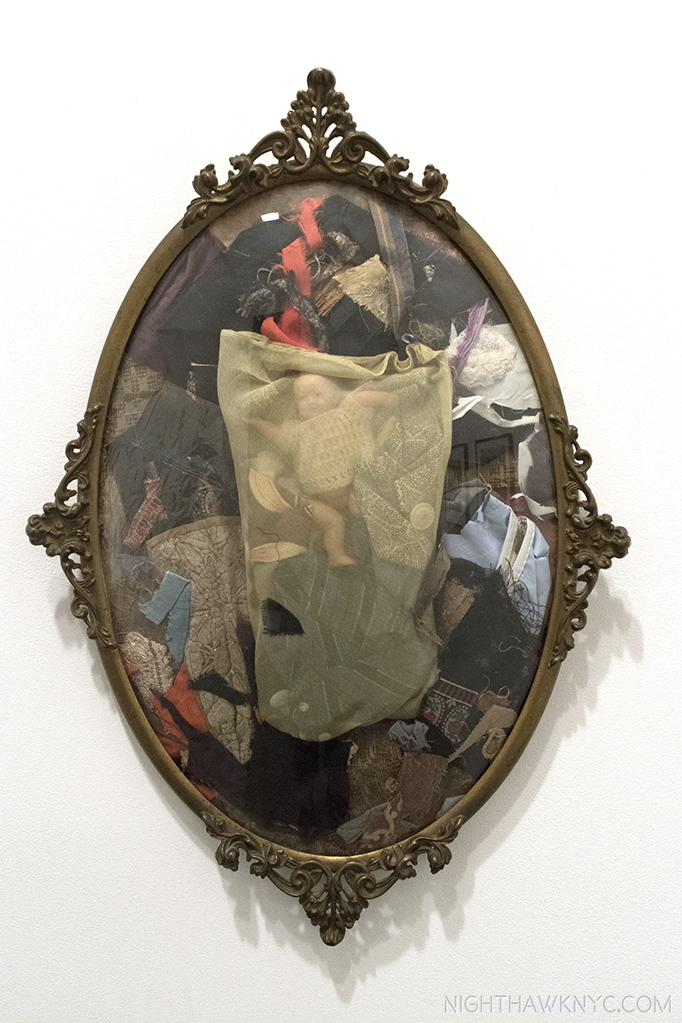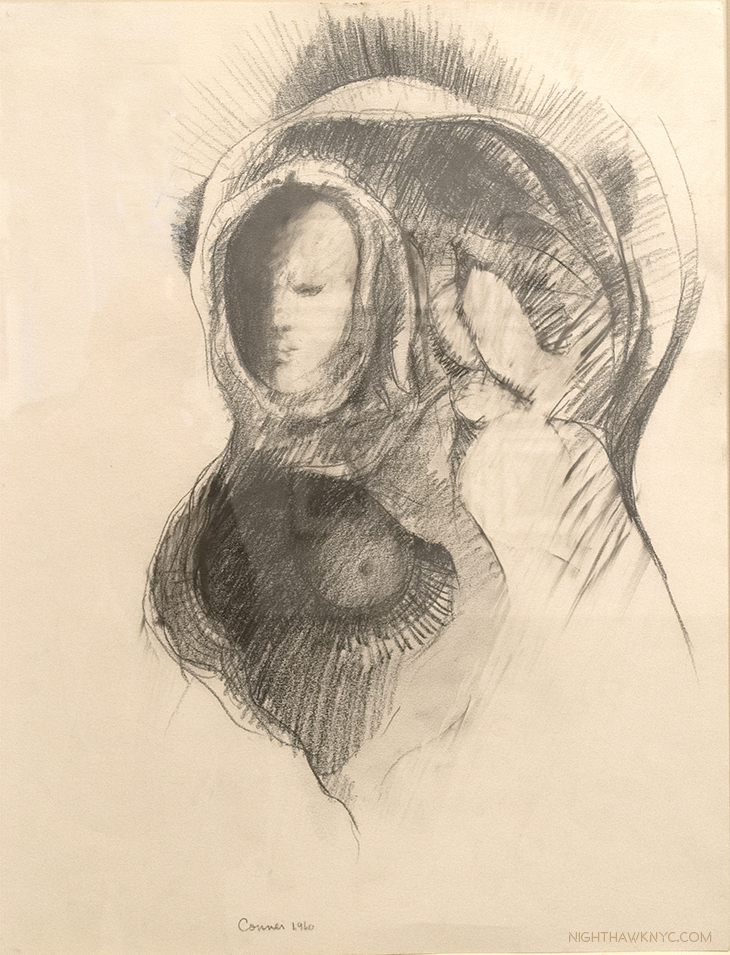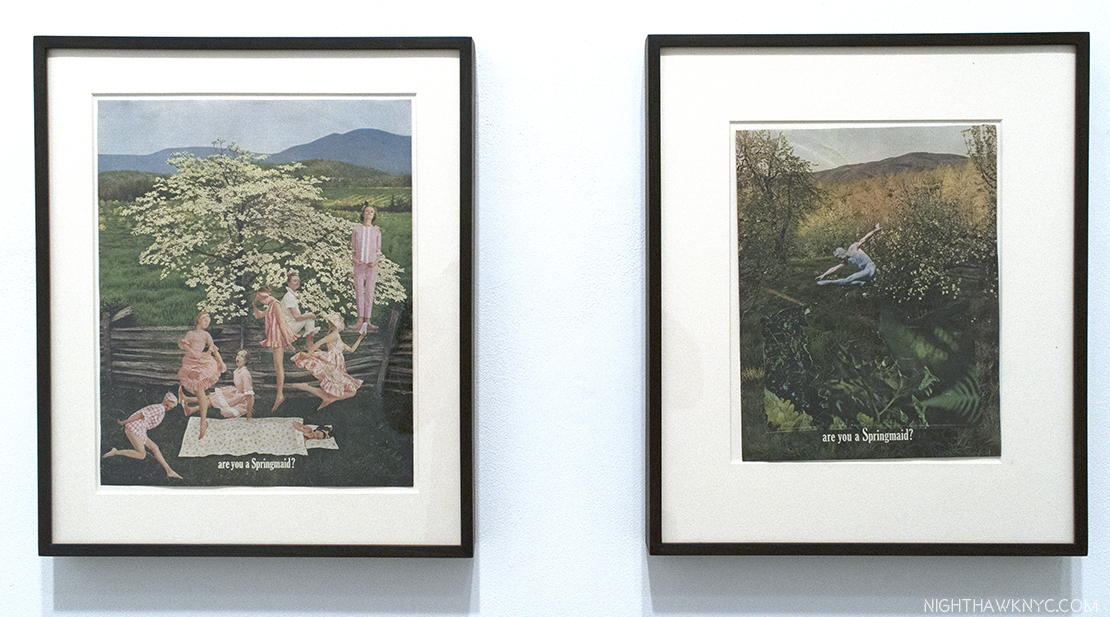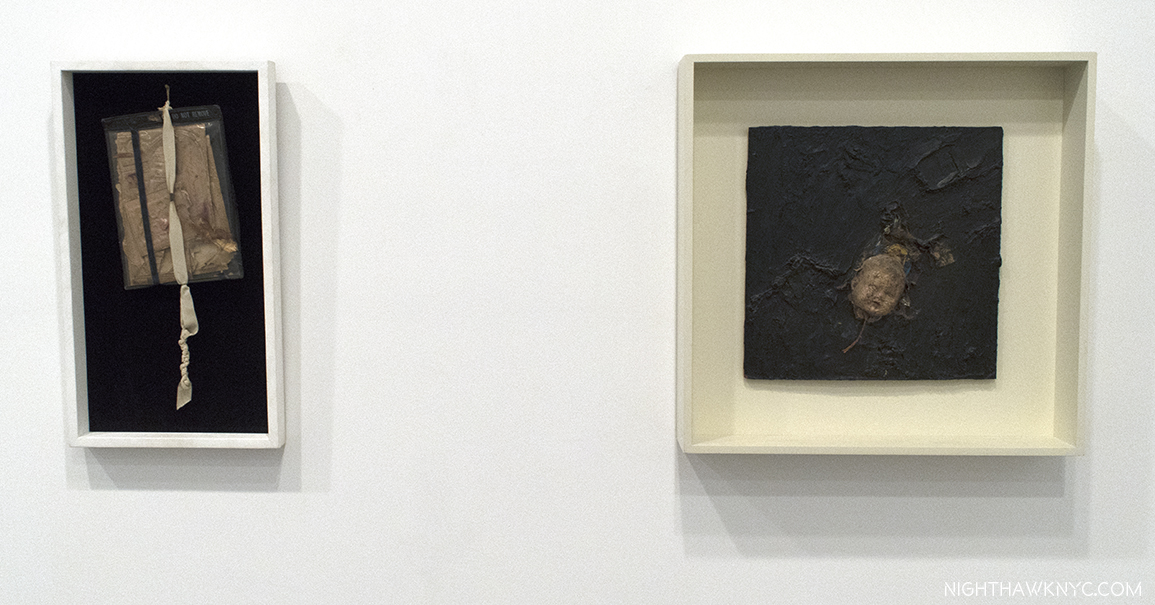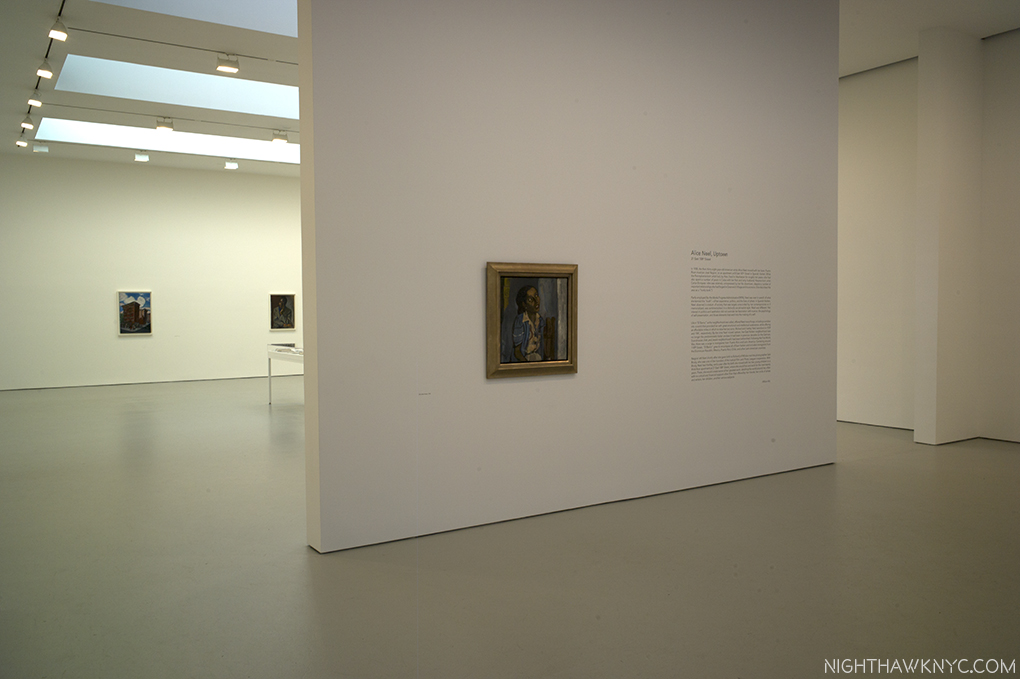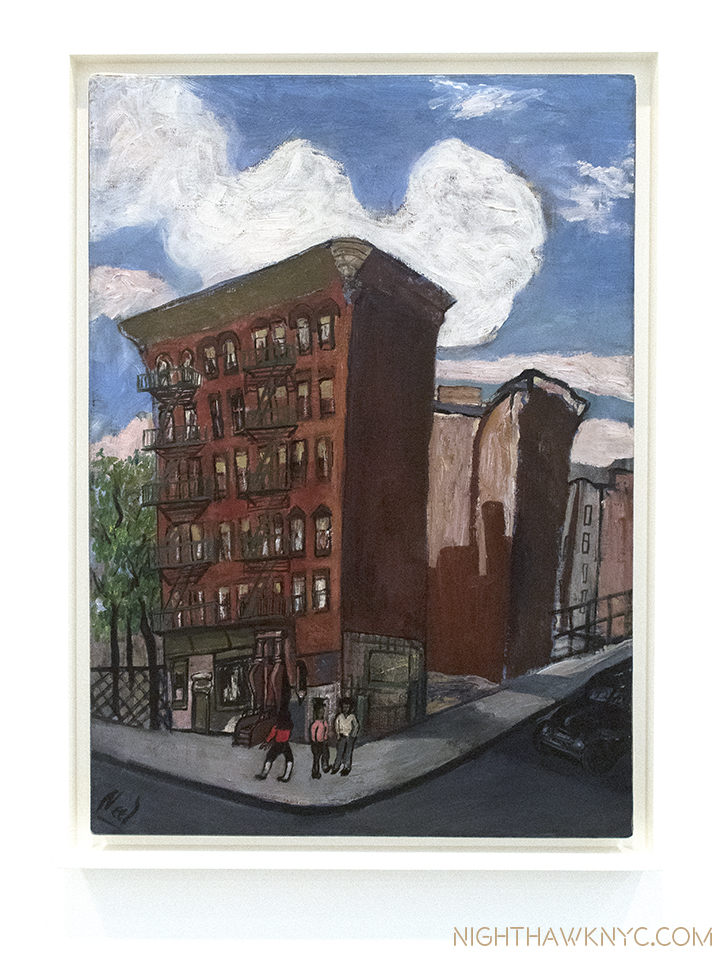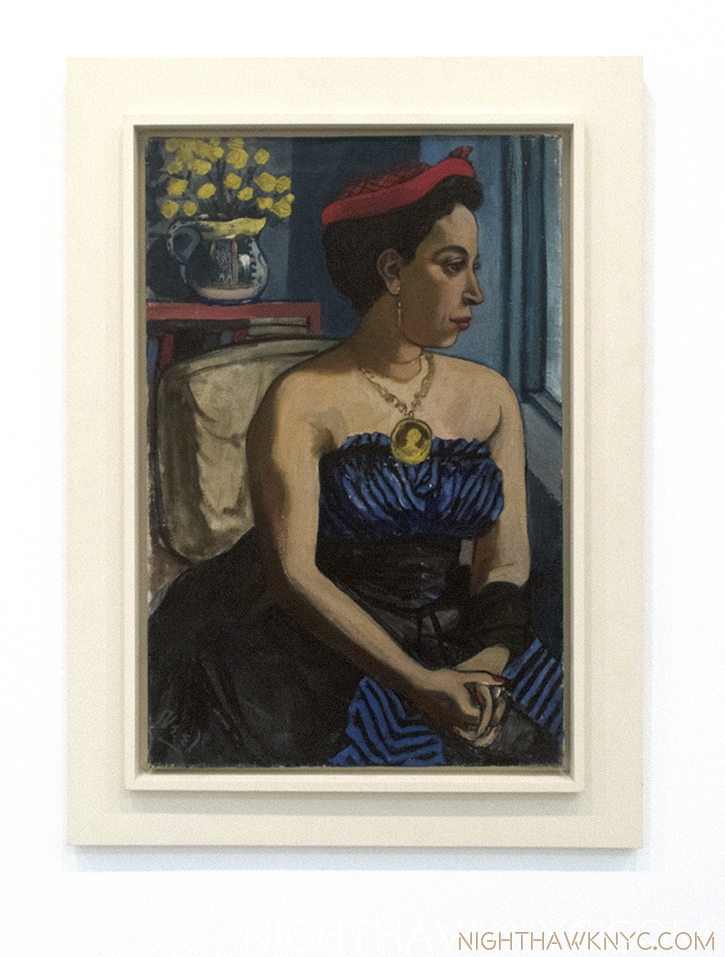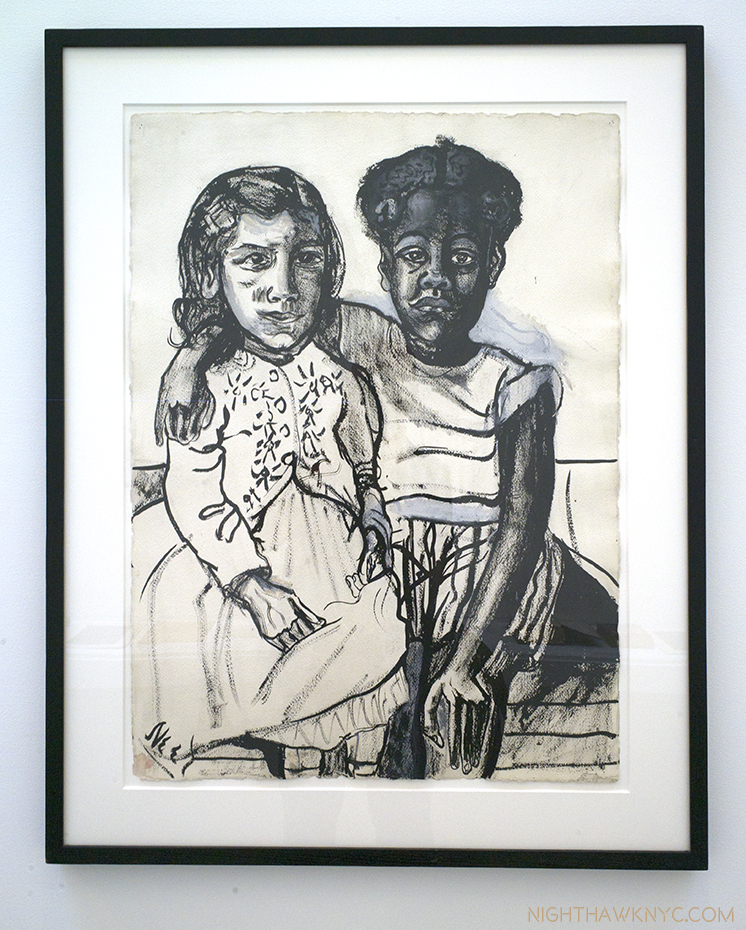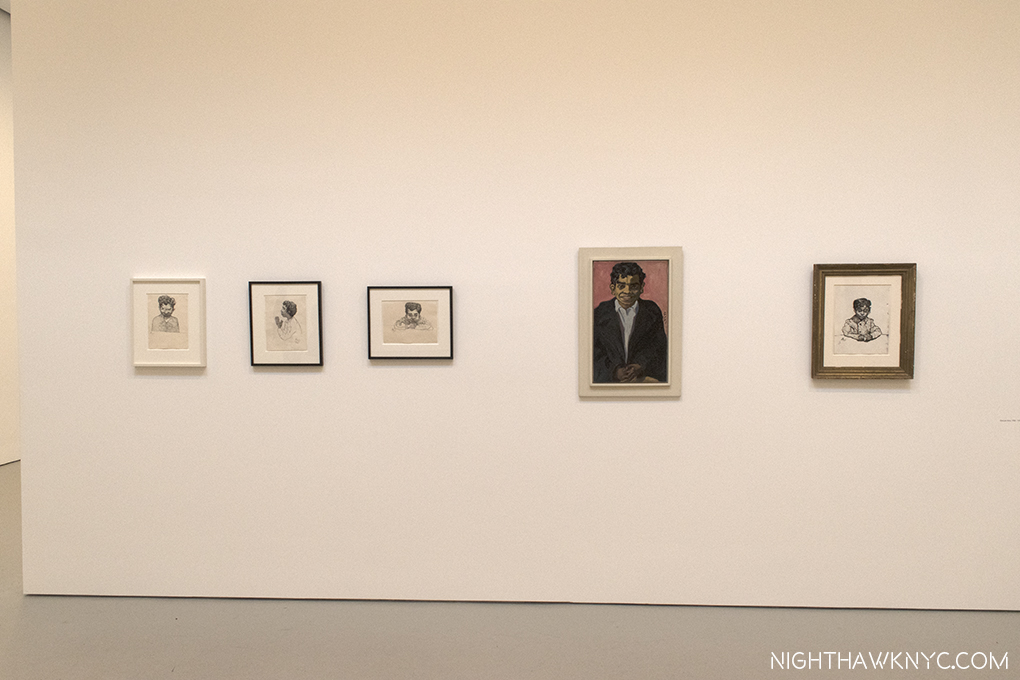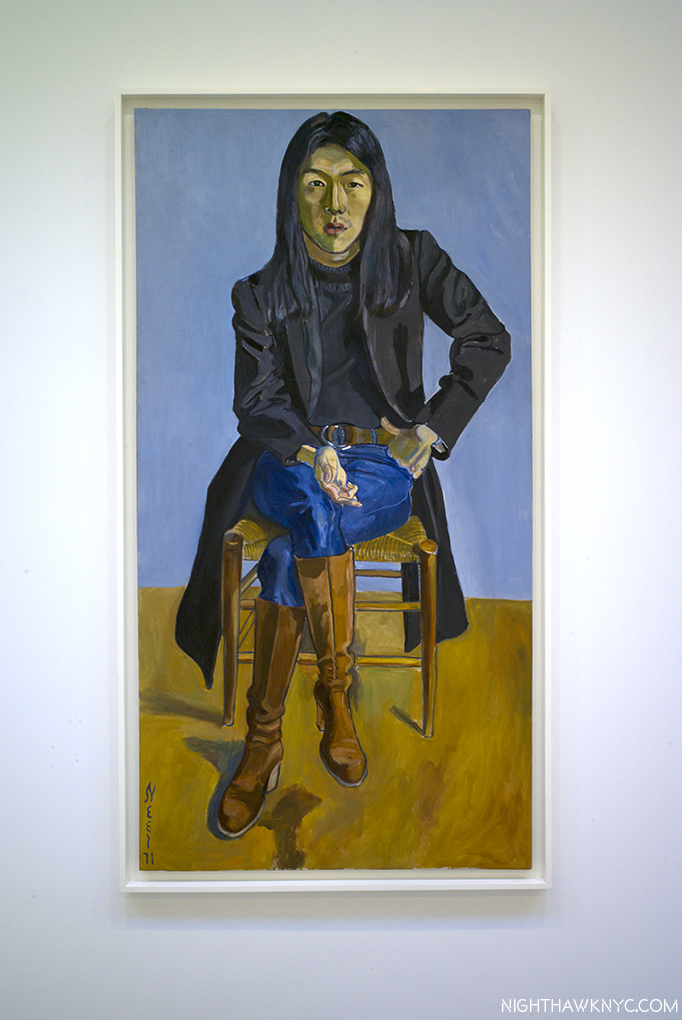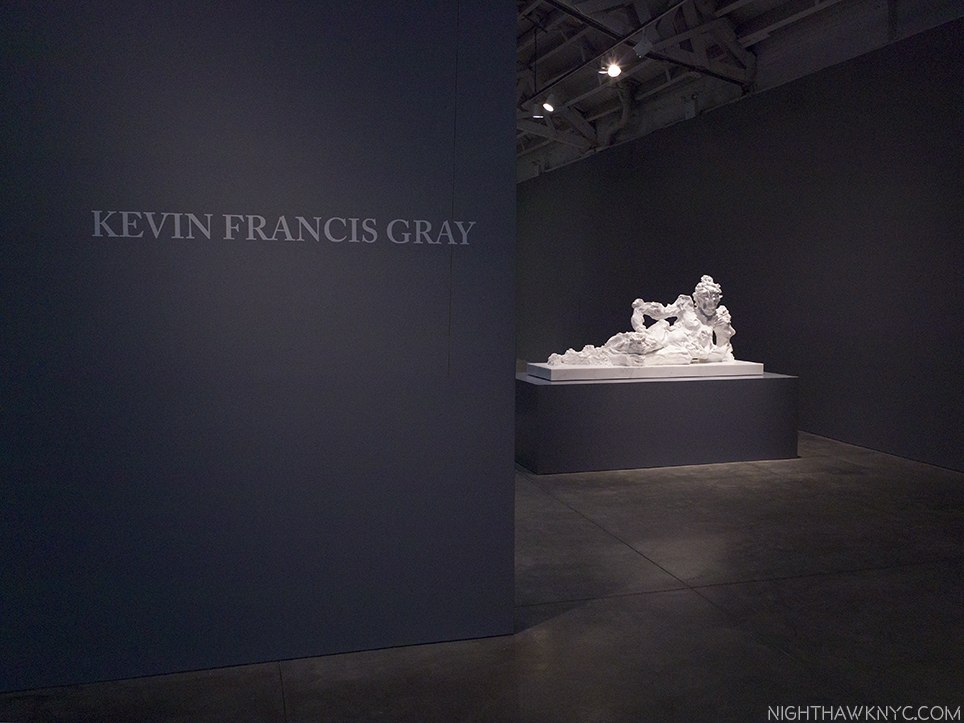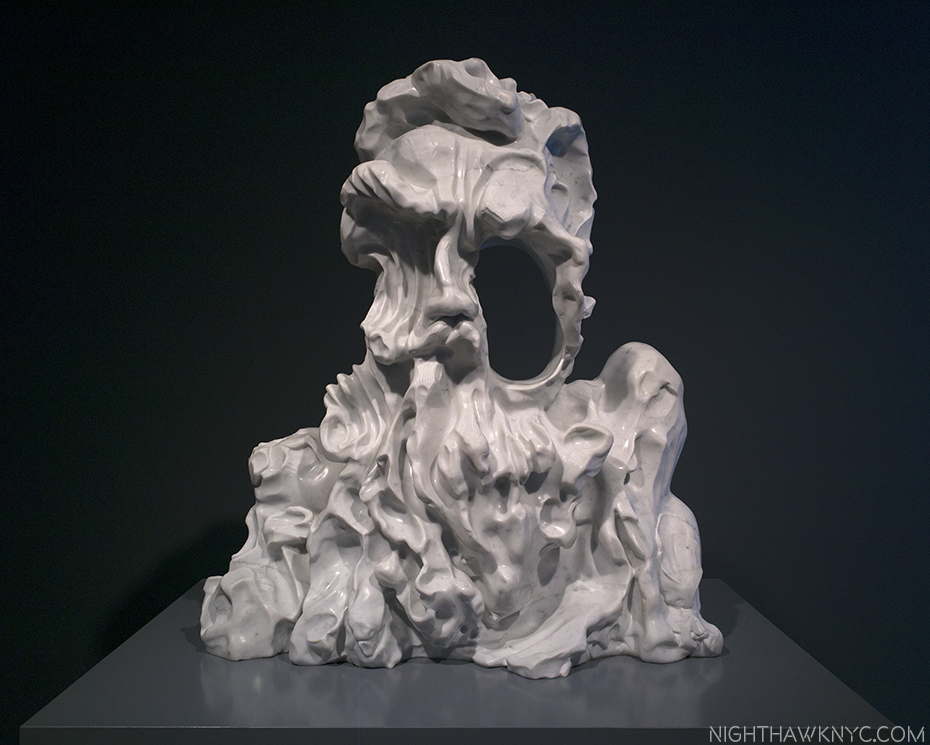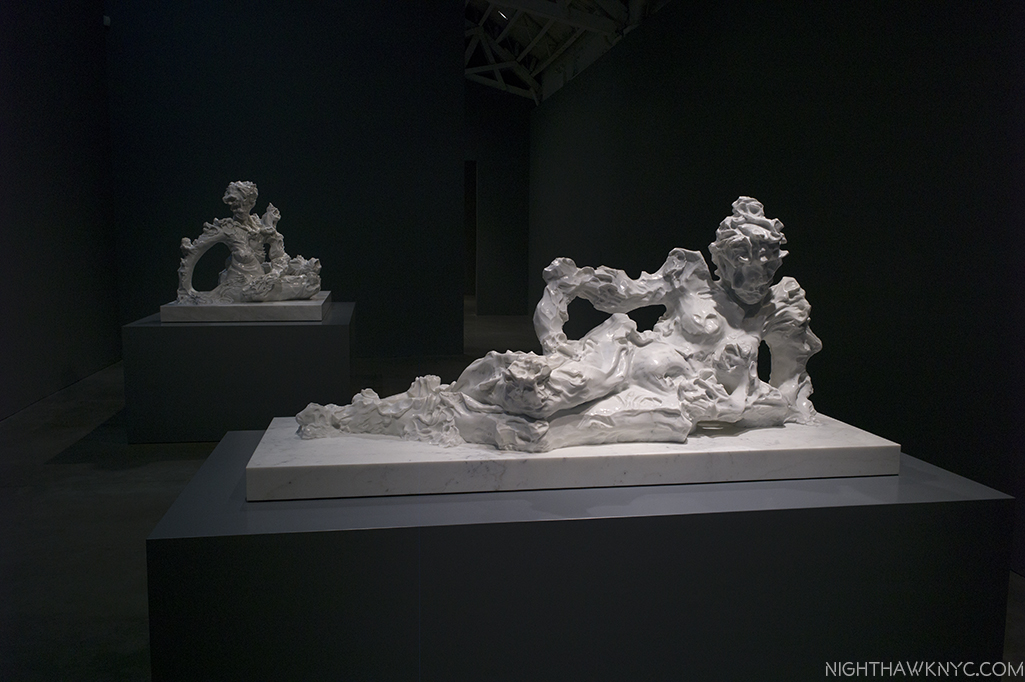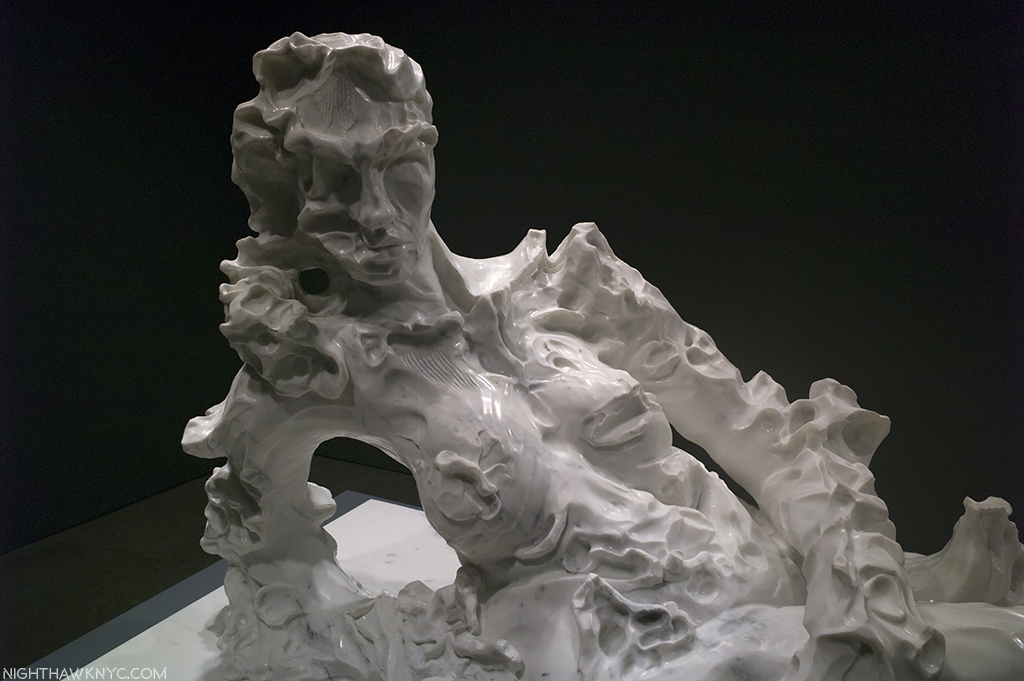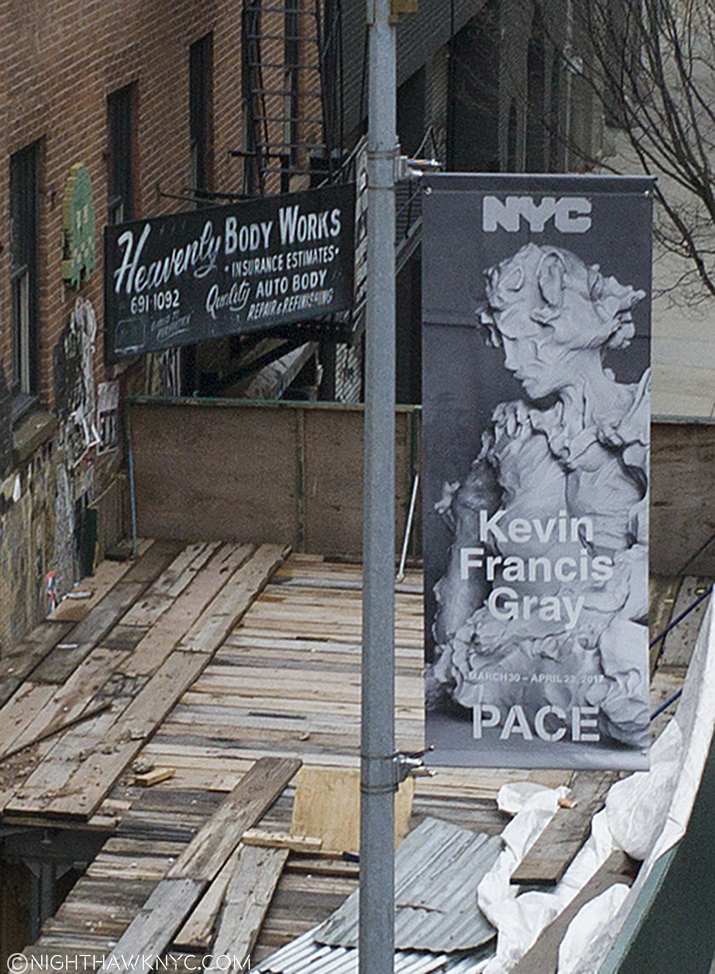Gumby had magical powers.
Using them, he was able to walk into books and become part of the story inside, usually solving whatever the problem was.
Well, his “super human” powers really shouldn’t surprise anyone. He wasn’t human! He was 100% clay. Most people who remember Gumby remember him as a character in a kid’s TV show from the 1950’s that was reincarnated a few times over the succeeding decades. Most recently, he’s also had a reincarnation as the alter ego of Artist Raymond Pettibon1. In this “life,” he doesn’t have to walk through the walls David Zwirner to be inside the story, he’s been welcomed in as part of Pettibon’s latest show, “TH’ EXPLOSIYV SHOYRT T,” as we shall see. Ok…ok…that’s my Gumby, above, that’s been a sidekick of mine going back to the 1990’s. But, Gumby, I mean Raymond Pettibon, really did create those paint splatters while he was creating many of the works in the show. Renown for the hand drawn & painted elements he creates for each show ranging from texts to wall drawings to murals, these splatters and drops provide mute testament to his creative process that recently occurred in this very space, possibly including this-
Fresh off the unabashed success of his blockbuster retrospective at the New Museum, “Raymond Pettibon: A Pen of All Work” (which I wrote about here), his first show at a major NYC Museum, some 40 years in the making, with EIGHT HUNDRED works dating back to the 1960’s filling three full floors, barely had my thoughts about it had time to begin to congeal, when along came word of a show of new works by Pettibon at David Zwirner, 519 West 19th Street, where the Artist had been holed up since January, I was told, creating many of them.
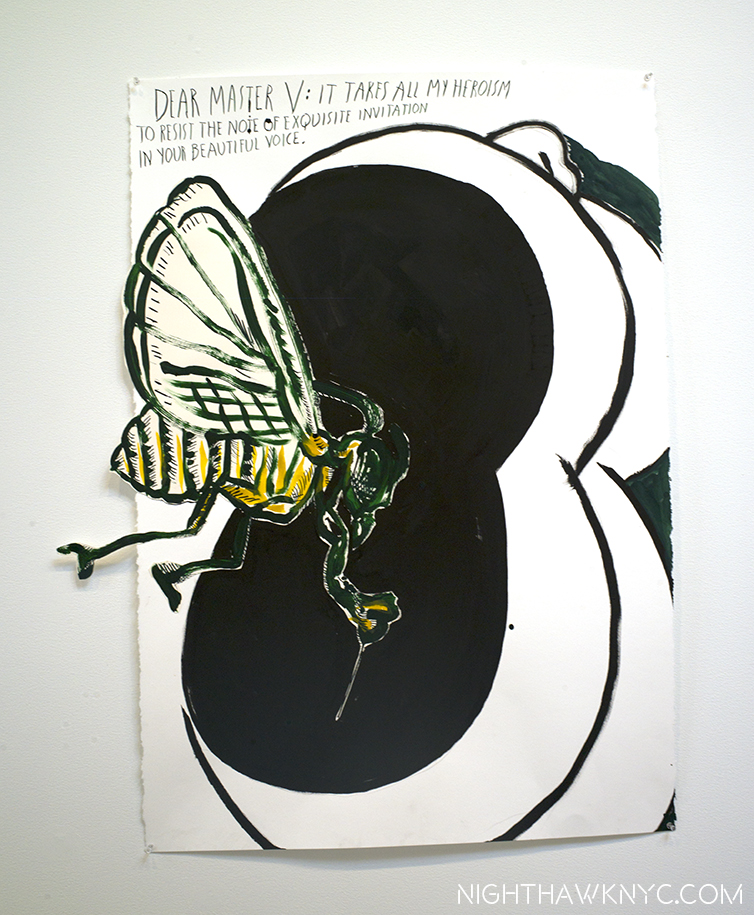
Down the rabbit hole I go, again. “No Title (Dear Master V…), 2017, “V” for Vavoom, the old cartoon sidekick, capable of only screaming his own name, is the other Pettibon alter-ego, along with my friend, Gumby. Pencil, ink, watercolor, goucache, acrylic and collage on paper.
Lo and behold, when the doors opened on Saturday evening, April 29, there they were, 99 new works, only 2 of which I saw at “A Pen…,” where they were tacked up as part of the lobby Mural, as if giving us a taste of what was to come. Talk about prolific. What’s another 100 after having just seen 800? It, also, provides an all too rare opportunity to get the “rest of the story,” from his beginnings as seen in “A Pen…” right up to the present moment.
Meanwhile, “A Pen of All Work,” has now opened at the Bonnefantenmuseum, Masstricht, The Netherlands, where it will remain open until October 29, complete with it’s own brand new, hand painted, circular wall mural, in 4 parts, which may be glimpsed here. Look now while you can. Like his other murals, it will be history when the show is. But, here & now, in West Chelsea, the paint was barely dry on the walls, and the floor, too, of 519.
What was to come, as far as the new work goes, was a continuation of what we saw in “Raymond Pettibon: A Pen of All Work”- in almost every way, most importantly including quality. Also continuing are most of the themes Pettibon is known for. Well? There was only one work related to Music, perhaps surprising to those who still think of Pettibon as a “punk” Artist, even though that period was 35 years ago. On the other hand, of all things, wrestling appears to be on the ascent among his themes.
But, before we get too far into it, let’s start outside. Above the door, in lieu of one of his usual wall drawings or murals Raymond Pettibon has simply written the show’s title. Keyword: “simply”-
Well? “The Explosive Short-T” is one version of the show’s title. On the David Zwirner website, the show is referred to as “TH’ EXPLOSIYV SHOYRT T.” That’s easy for Raymond Pettibon to say, in his unique “way with words,” something I am quite fond of doing, myself. Two titles? What gives? I was told the latter is the “official title.” Fair enough. But? What does it meayn? My research led me to the 1963 Football coaching guide by Homer Rice, a coach at the University of Oklahoma, called “The Explosive Short-T.” It’s back cover bills it as “A complete guide to building a winning football offense with the newest and most powerful variation of the T-formation.” And, compared to the massive “A Pen…” it is short-er.
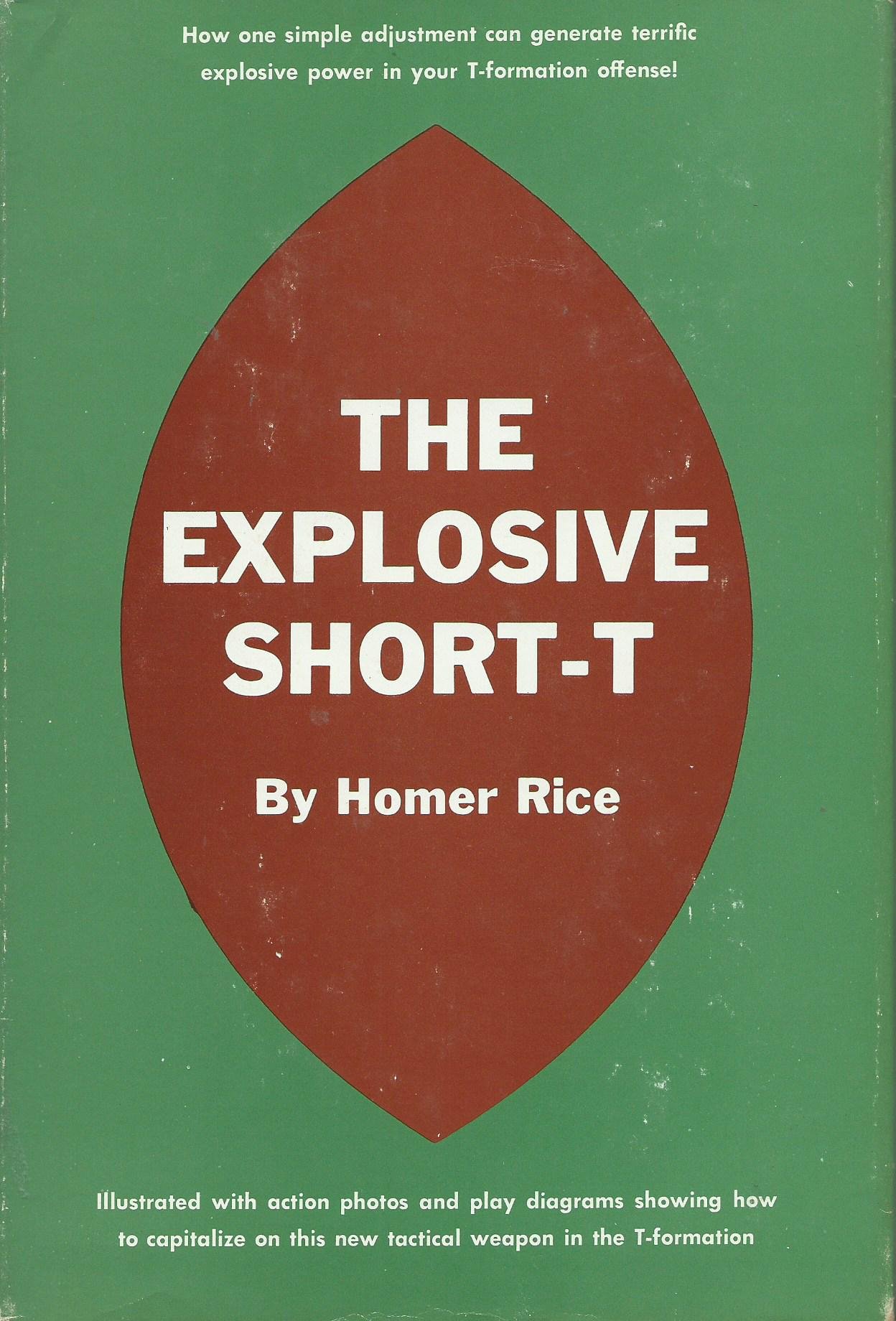
The cover of Home Rice’s rare 1963 book. I don’t think he suspected his title would also be that of an NYC Art show 54 years later!
I know what you’re thinking- “Of course!” Further adding to the intrigue of the title, among the works inside pinned, (yes, Art, some of which was priced at $150,000.00 per, was all pinned to the walls), Raymond Pettibon, sports aficionado, has depicted the following sports (and in parenthesis how many times each in this show). For those of you keeping score at home, my count by sport is-
-Baseball (4)
-Wrestling (3. One could be boxing, but I think it’s wresting.)
-Surfing & Waves (2. 1 of waves, 1 of surfers changing their clothes)
-Football (None)
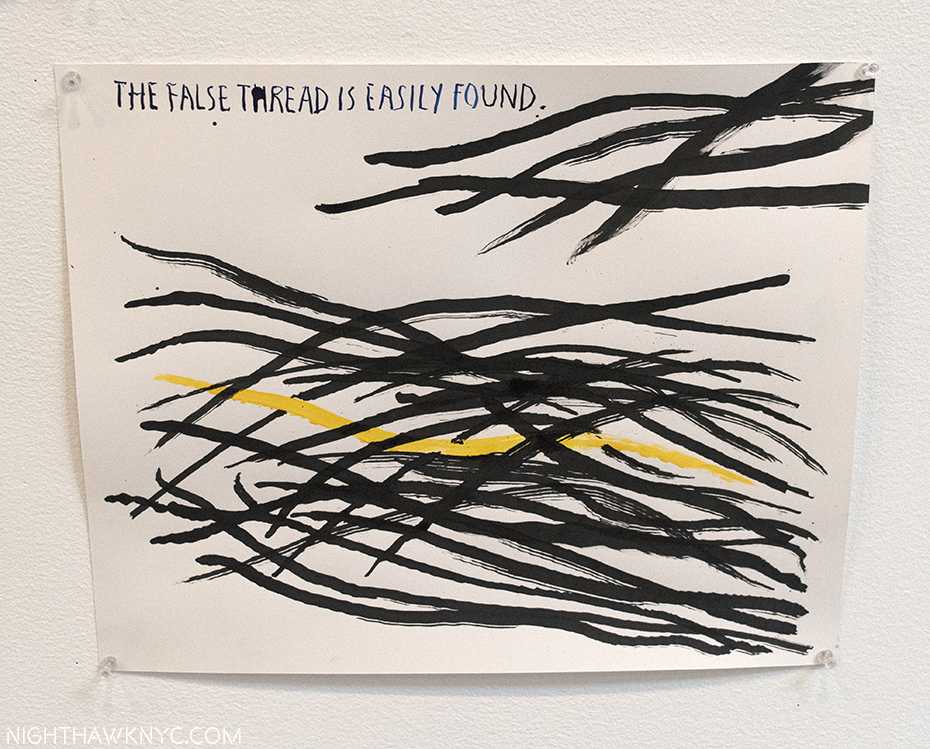
“No title (The false thread…,)”,…is easily found,” it concludes. All works are by 2017, Ink and acrylic on paper, unless noted.
Ok, so if the show’s title is a Football reference and there’s no football to be seen, what does it have to do with the 99 Art works on display? Unless it’s a “false thread?” I don’t claim to have any “answers” when it comes to the work of Raymond Pettibon. I just enjoy pondering what his work says to me each time I look. Not willing to give up on this “thread” so quickly, I chose to take the “formation” part literally, and see what the groups (the formations) the work is arranged in might offer.
The first thing that struck me about the curating of this show was a major difference with the New Museum Retrospective, which was arranged by themes throughout it’s 3 floors. This show is not, as far as I can tell. I asked who was responsible for the arrangement and the answer I got from the staff was Pettibon and David Zwirner. I’ll go with that. It’s hard for me to imagine the Artist didn’t have a hand in it. Afterall, he had been in this space working, and he did paint the title over the door, and? The grouping is as interesting to consider as the individual works they consist of. But, I must bear in mind what Pettibon said in 1999-
“When I hang a show, for the most part, it’s usually just as well to put up the drawings randomly, because that’s the nature of the work. There are dissociations and attachments and the mind will fill in the blanks. Beyond that, it becomes overly fussy and contrived. So just about any way the work is hung, really, it’ll work.”
Yes, my mind couldn’t help but to “fill in the blanks,” helping to see the combinations as “explosive.” Take the group, above, for example. Right smack dab in the upper middle is a work, who’s upper thought bubble says-
But then, the “kicker.” Under a pile of black lines, the words “Was there any going back on that? It seem’d ready to unravel.” What do they refer to? Slightly higher, on the left, is a skull, with a thought bubble that reads “Little Cloud That Cares.” Two brains, one in a skull, connoting a “dead” brain, and one, of an apparently “live” brain, without a skull, both with thought bubbles. On the left side, directly under the “Cloud That Cares” is a drawing of 2 Baseball players. Bo Billinsky and Dean Chance. During the opening, on April 29, Raymond Pettibon told me that his son, Bo, who was in attendance, was named after Bo Belinsky. Bo Belinsky, was a 6′ 2 left-handed starting pitcher for the L.A. Angels, from 1962-64, when his record was 21 wins and 28 loses. An interesting choice, to say the least.
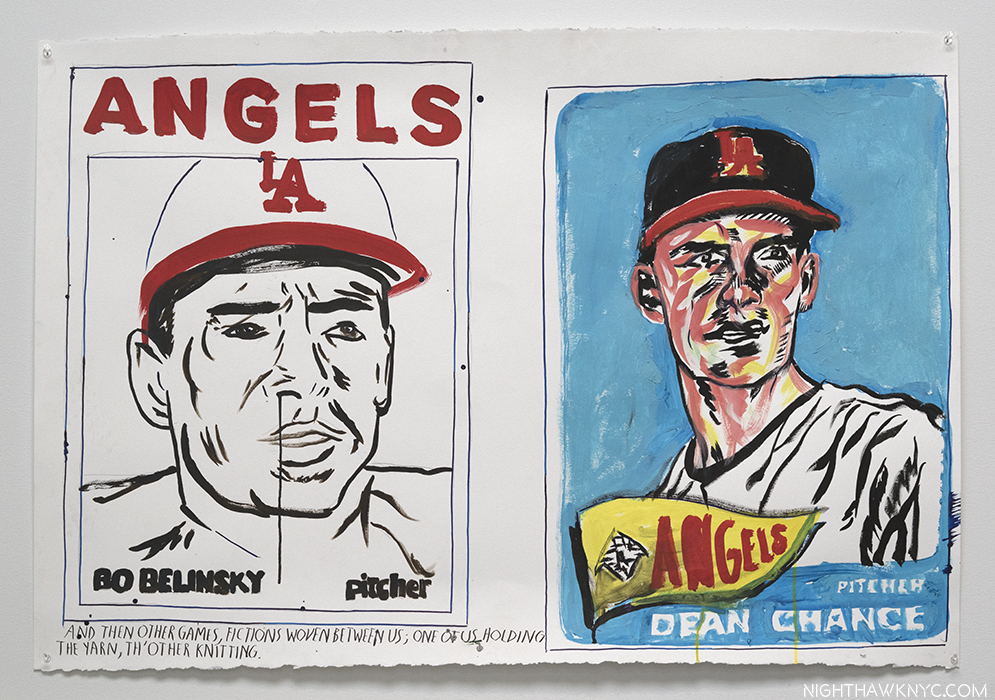
Pettibon’s son’s namesake, alongside his own favorite player. “No Title (And then other…),” Pencil, ink, watercolor, gouache and acrylic on paper.
He also told me that Dean Chance was his favorite player, so (my interpretation) their dual portrait is a way of putting himself and his son into a work. (The Artist also has a dog named Boo.) Bo Pettibon announced to all who would listen that he wanted to become an Artist. In an interview with Dan Redding, Raymond Pettibon said that he looked forward to collaborating with Bo. So? This piece may also be a harbinger of Raymond Pettibon’s future work. It appears to me, though, this this is a rare work that may have some personal relevance to Raymond Pettibon. It’s fascinating to me how very few of his works that I’ve seen seem do. It seems to me his work is more about “self,” not about “him self.”
Surrounding these 3 works are pieces that speak of luck- good (below, center, a skier apparently narrowly misses a tree), bad (upper right- a bomber on fire, seemingly about to crash), faith (a bible, or bibles, seemingly falling), fate (a naturalist monitors the progress of his disease in a piece that seems to equate the progression of a disease to a pen that finally produces ink). Beneath it is a most interesting image. Gumby/Pettibon and Shakespeare are joined by a quintet of 4 men and a woman. The man in the center holds what appears to be a frame. The text reads, “As withouyt the advantage of educatioyn or acquaintance among them.” The man holding the frames looks like he could be Churchill, a passionate painter throughout his life, to me. The man to his left (the far right) could be Stalin. The man “Churchill” shows what’s in the frame to (F.D.R.?) appears to be startled by it, as does the man looking over his shoulder at it. Gumby, “represents me as an alter ego,” he said on PBS’ Art21. Yet, both he, and Shakespeare have blank expressions, appearing as witnesses, and either the piece in the frame is blank, if it’s facing us, or hidden, if it’s not. Either way? No matter how long we look at it, it will never become clear.
Fascinatingly, to it’s immediate right is an image of what might be a demon, with a red tooth, who is busy “Rereading Pettibon,” something many viewers to his New Museum Retrospective had just been busy doing, revisiting his work going back decades.
The final piece in this section’s bottom left features a pitcher nicknamed “Whipper,” who, it says, won 19 games in 1960. The only major leaguer to win 19 games in 1960 was Lew Burdette, but he lost 13 games, not 8 as it says on the drawing, and his lifetime record was 203 wins and 144 loses (not 161-127). So? Whipper may be fictional, or a non-major leaguer. Still, I find it, another, compelling Baseball work. While so much ink is devoted to Raymond Pettibon- “punk Artist,” very little is devoted to Raymond Pettibon- extraordinary “Baseball Artist.” Which leads me to ponder- Who is the OTHER great Baseball Artist?
So, the right half of this wall is dark with war, death, disease, demons, and trying to maintain your sense of self during this. In the middle might be luck- at writing one good thought or narrowly escaping serious injury/death. On the left side is an image of the Washington Monument with text reading “There is no other that in comparison with it stands,” but it mirrors the narrowly missed tree to it’s immediate right, and above everything else on this wall is a skull, a symbol of death, that somehow manages to produce a thought bubble “Little cloud that cares.” Clouds care? The dead have thoughts? I’m deeply inside the rabbit hole now. I make no claim to “understand” any of them. But? I just can’t stop looking at them, and thinking about them.
This is only one section of the show- 11 works. It leaves 88 others to consider! Don’t worry. Every now and then I remind myself that this is a Blog, not a Book, so I’m not going to go through all the rest. But, I will show a few others.

Installation view of ALL of “Raymond Pettibon: TH’ EXPLOSIYV SHOYRT T” at David Zwirner. The wall I was speaking about is just to the right of the left corner.
Of the other noteworthy works here is, of course, the huge Wave piece shown earlier, which, though 4 of his 5 highest selling works at auction to date have been large Surfer/Wave pieces (one sold for 1.5 million dollars), this one is mounted all the way in the back corner, high on the wall. So high, it’s very hard read the small text fragments among the collaged waves. Of course, it was sold early in the show’s run (if not before it opened), and most likely was the most expensive piece in the show. Well? It’s safer high up. It also does give the effect of looking up at a huge wave.
In his oeuvre, Pettibon’s surf pieces are like the “golden section” in a piece of Music-they live at the center of his universe. He’s said he enjoys Drawing waves more than anything else. It shows. This one is displayed above leftover paint splatters, and the portraits of two tyrants- Stalin, looking like he was the target of a paint gun war, and to his right, J. Edgar Hoover, cornered. For a change. Around the corner, on a wall by himself, hangs the only Self Portrait of the Artist, looking “cautiously” out on all he has wrought. Well, he not only can’t see Stalin or J. Edgar from there- he has his “back” to them.
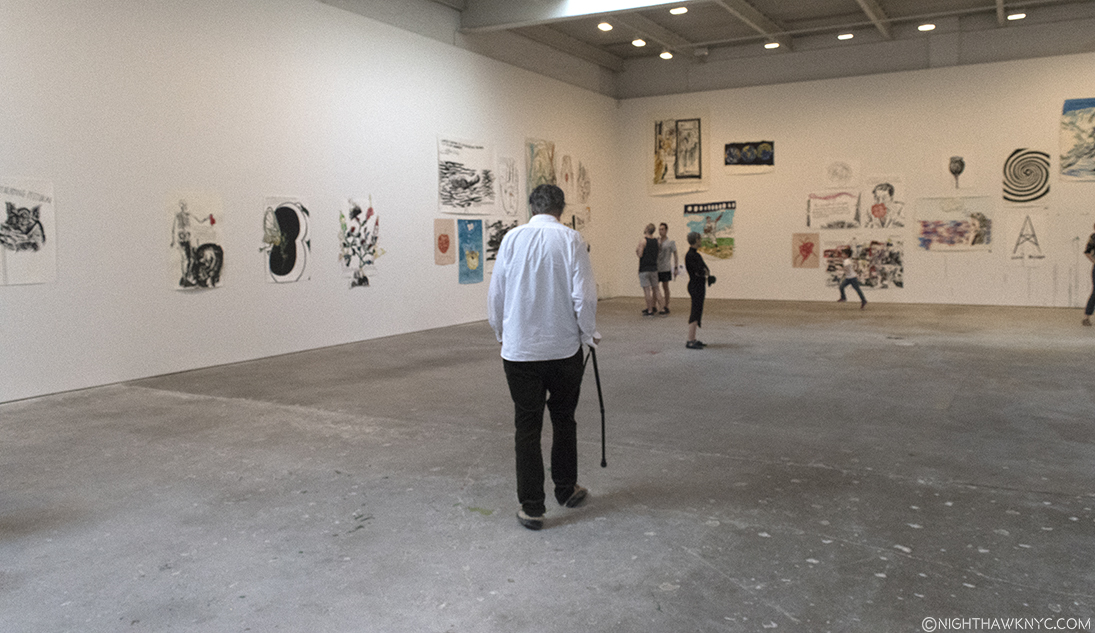
moving cautiously around it, too. Raymond Pettibon enters his show at the opening, April 29, with a cane. That small figure running in the distance is his son, Bo.
Hobbled by what he said was a bout of gout, the Artist, himself, nonetheless persevered and arrived to surprise visitors to the opening, including yours truly, with his presence, and I had the privilege to meet him and speak with him.
We spoke about a range of things after I remarked that since he is associated with many things California, I was still getting used to him being a New Yorker, which he has been for six years already. We then touched on the Biennial, Owls (which appear fairly often in his work. He then proceeded to sketch this one-),
Baseball (as I mentioned, above), and some of the books about his work. His son, Bo, came by and drew in a fan’s book his father was signing, and announced to all present his intention to become an Artist. Pettibon has spoken about looking forward to collaborating with Bo, so Craig? Hang on to that drawing! Bare chested, Bo then proceeded to run out to the sidewalk and take startled passersby by the arm to try and get them to come and “see Daddy’s show.” As I commented to the staff, you can’t buy that kind of marketing!

If you thought the first group of 11 was “complex,” 42 works line the very long eastern wall in one group. At the far left is a work about the beginning of life (shown below), at the far right, one about death (JFK’s). Smack in the middle is a large cathedral piece, with a UFO work over it, and one, perhaps, about suicide, and the luck of dice to their right.
It’s too early to calculate Raymond Pettibon’s influence because it’s still in the process of spreading, something which no doubt surprises many who only know him as a “punk Artist.” His has become a world-wide presence, with shows going on in Moscow, and “A Pen of All Work” reinstalled in the Netherlands as I write this. Over the past 40 years, he’s gone from being a shadowy background figure, creating fliers, record covers, zines and Artist’s Books, to being an established Artist in the world of “Fine Art,” who’s work is now being shown, more and more, in Museums. Around the world, in press releases, he’s invariably referred to as an “American Artist.” “Artist Americanus” is my play on “Homo Americanus,” the title of a large traveling European show of his work last year (which I take to mean “American Male”). When I think of that term in a “classic” sense, it means thinking for yourself, making up your own mind, and expressing yourself in your Art.
Regardless of whatever “meaning” you take from one of his works, Pettibon is an Artist who has maintained a remarkably consistent creative path since, at least, the mid- 1970’s. He’s said in interviews that he’s worked like this (putting words to drawn images) since he was a small child. Right now, 40 years on, Pettibon’s influence can already be seen even beyond his work, itself. The “alternative means” he used to get (fliers, zines, record covers, Artist’s Books, et al) his work seen2 is being followed by countless others, as can be seen at New York’s “Printed Matter.”

New York’s renowned “Printed Matter,” where the work of some Artists following in Pettibon’s footsteps is available, has over 15,000 titles in stock.
I, too, have been inspired by his example with this site, and I thanked Pettibon for the “inspiration,” when we parted. I’m not sure he knew what I meant. Beyond this, his other great influence is helping Drawing to be reborn in Modern & Contemporary Art. Artist (and Pettibon collaborator), Marcel Dzama credits Pettibon for being the Artist who put Drawing on the map in Contemporary Art3, and getting it taken “as seriously” as “finished works of Art,” and not as preliminary works for a Painting. That, too, seems like it’s already ancient history.
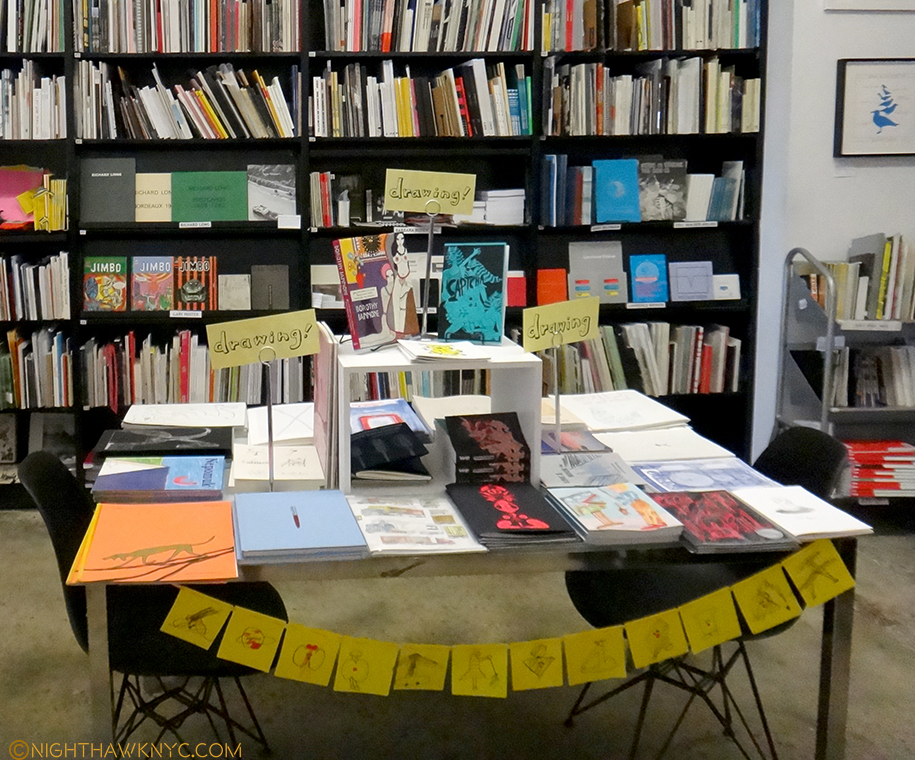
Inside “Printed Matter,” a table features recent Drawing books. A few years back, you’d look long and hard to see books of Contemporary Drawing.
When “A Pen…” opened at the New Museum, it was February 8th. 900 works later, when the Zwirner show ended, it was June 24! Most of 5 straight months of Raymond Pettibon! Still? I was already thinking- When’s the next show? It turns out I didn’t have to wait long. On June 27th, David Zwirner opened the “Thread Benefit Exhibition,” featuring 26 works donated by gallery Artists, a few doors west at 533 West 19th Street. It includes this piece by Raymond Pettibon,
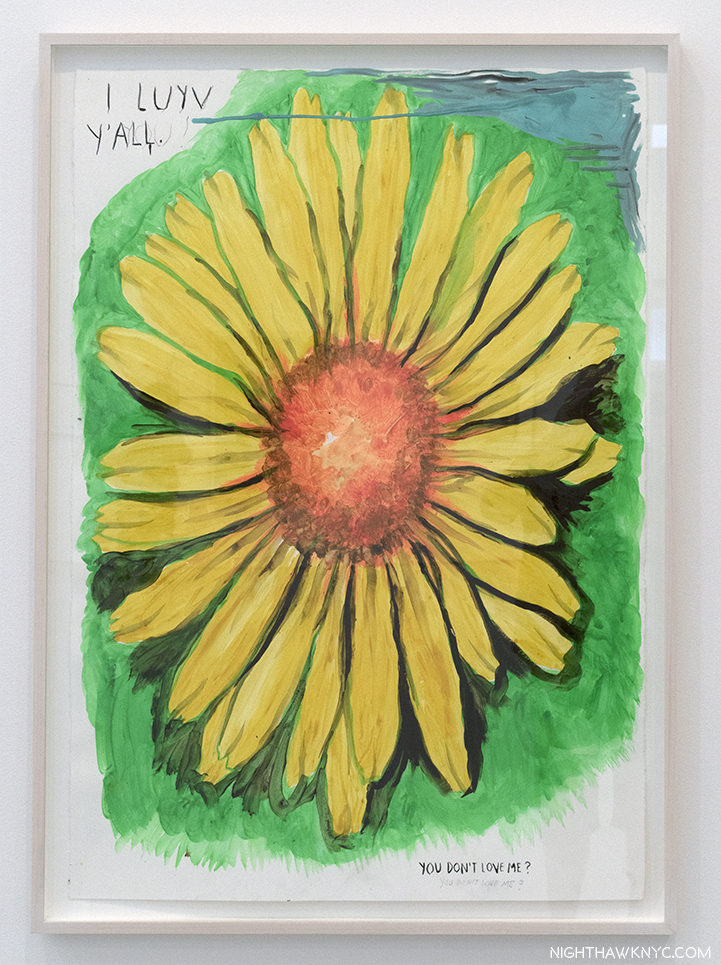
“No title (I luyv y’all…), 2014, “You Don’t Love me?” Ink, graphite, and acrylic on paper. Seen at the June 27th opening of “Thread.”
which speaks for itself. Or? Does it. I’ve been “trained” to look twice. Thus far, it strikes me as a terrific culmination to this remarkable “half year of Pettibon, NYC.”
The Artist didn’t appear, at least while I was there, that night. Leaving, I passed by 519, where “TH’ EXPLOSIV…” had ended 3 days before. I looked in and saw the wall he hand painted had already been painted over in preparation for whatever is going in there next. I turned the corner onto 10th Avenue, and a few hundred feet down, I saw this, propped up against the wall…
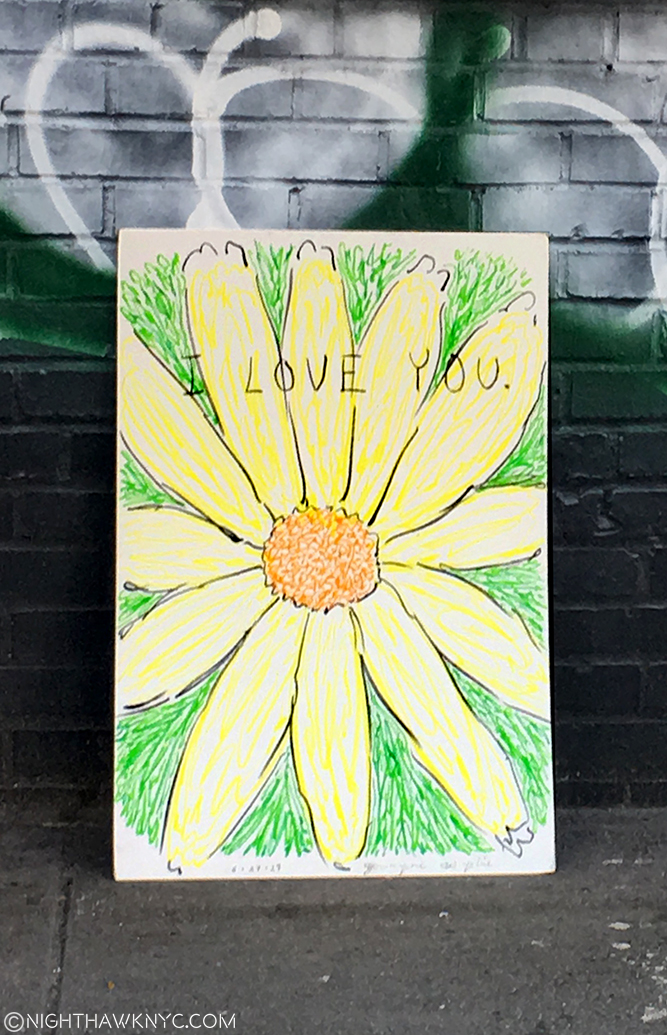
Unknown Artist, “I Love You.” Dated June 27, 2017 along the bottom, Unknown medium, seen on 10th Avenue, June 27, 2017,
What? The show had been open all of one hour, and already someone had copied Pettibon and had it up for sale on the street! WHOA. I was reminded of this quote of his- “I’ve never really thought of it in this way, but it is kind of cool to be the Gucci of my kind of work. I mean that in the way that Gucci and all those type of trademarks can be cheaply copied and reproduced like my comic books or flyers. I don’t get any royalties from that. I haven’t got a cent from SST ever, and I don’t get any royalties from the tattoo trade. The tattoos are when it becomes an even more substantial brand because it’s stuck on someone permanently. And if someone wants it off, then the mother has to go through even more pain to have it taken off than he did to put it on,” he said here.
I’m not the only one who owes Raymond Pettibon a “Thank you,” at least, for the inspiration.
“Raymond Pettibon: TH’ EXPLOSIYV SHOYRT T” is my NoteWorthy Show for June, 2017.
My thanks to Craig, Anisa & Caslon of David Zwirner for their assistance, and forbearance, during my dozen or so visits.
*-Soundtrack for this Post is “Don’t Believe The Hype,” by Public Enemy, for all those who hear that Pettibon is a “punk Artist.” And, because Pettibon loves hip-hop, some East Coast.
NighthawkNYC.com has been entirely self-funded & ad-free for over 7 years, during which over 275 full length pieces have been published! If you’ve found it worthwhile, PLEASE donate to allow me to continue below. Thank you, Kenn.
You can also support it by buying Art, Art & Photography books, and Music from my collection! Books may be found here. Music here and here.
Written & photographed by Kenn Sava for nighthawknyc.com unless otherwise credited. To send comments, thoughts, feedback or propositions click here. Click the white box on the upper right for the archives or to search them. Subscribe to be notified of new Posts below. Your information will be used for no other purpose.
- “Gumby represents an alter ego for my work as an artist. He represents me as an alter ego. There’s actually a lot more to that figure than just ninety-eight ounces of clay or whatever. Art Clokey was into Zen Buddhism and into a lot of pretty deep stuff for Saturday morning cartoons. Clokey was a pretty hip figure in Los Angeles and in the counterculture of the ’60s and the ’50s—the beatniks and the hippies. I have a lot of respect and affection for him, and for Pokey as well, and Goo, Prickle, and even the Blockheads. One other thing that I’ve never thought of—that Gumby does for me in some of his cartoons—is he goes into a biography or historical book and he interacts with real figures from the past: George Washington or whatever. And I tend to do that in my work and in my videos, as well.” From Art21.
- Not always successfully. He’s said repeatedly he wound up giving away or destroying most of the copies of his self published early books, making them very rare today.
- Along with William Kentridge, R. Crumb, Robert Longo, and a few others.

